



www.therobotreport.com A Supplement to Design World • April 2024 ISSARONOW ADOBE STOCK
























Quality Linear Motion Solutions from THK
THK is committed to meeting the worldwide demand for linear motion products. We manufacture, assemble, and ship across North America from our location in Hebron, Ohio. We’ve also ramped up our automating processes at existing facilities, including our U.S. manufacturing plant, where over 70% of THK Robotics Components are manufactured. Automated processes at this state-of-the-art facility enable increased production while maintaining the high standard of precision associated with THK products. To learn more, visit www.thk.com





LOCAL MANUFACTURING WORLD-CLASS LINEAR
1–2 Week Delivery of Select LM Guides and Actuators QUICK SHIP COMPONENTS THK Manufacturing in Hebron, Ohio
MOTION
Ultra-Lightweight, Compact Gear Units



Introducing a new series of ultra-lightweight gear units featuring a newly engineered lightweight structure with an ultra-compact shape. Ideal for use on end of arm axes for small industrial and collaborative robots, the CSF-ULW is also well suited for general industrial machinery where weight is a critical factor. The two smallest sizes, 8 and 11, are available today. Other sizes coming soon!
• Zero Backlash
• High Accuracy
• Ultra Lightweight
• Ultra Compact
• Reduction Ratios 30:1~100:1
• Super Flat Configuration, 19mm (size 8); 21.5mm (size 11)
• Outer Diameter: φ 42.5mm (size 8);
φ 50.5mm (size 11)
• Weight: 90g (size 8), 150g (size 11)

NEW! Harmonic Drive is a registered trademark of Harmonic Drive LLC. 42 Dunham Ridge, Beverly, MA 01915 | 800.921.3332 | www.HarmonicDrive.net
RBR50 AWARDS RECOGNIZE INNOVATION AND EXCELLENCE IN ROBOTICS
A CLOSER LOOK AT THE NOTABLE WINNERS OF THE RBR50 ROBOTICS INNOVATION AWARDS

The RBR50 Robotics Innovation Awards have honored industry leaders for the past 12 years. And now we’re taking the RBR50 to the next level.
We introduced three new categories in 2024 – Robot of the Year, Application of the Year, and Startup of the Year –and will be holding the inaugural RBR50 Gala on May 1 from 6-8 PM at the end of Day 1 of the Robotics Summit & Expo.
The RBR50 Gala offers a chance to connect with the world’s leading robotics innovators. It’s also an evening of celebration to honor leading roboticists and their impressive achievements.
You can find profiles of all of this year’s RBR50 winners on The Robot Report
Digit is Robot of the Year 2023 was the year of humanoids, and Agility Robotics has taken an early lead with commercial trials. The company’s Digit humanoid stole the show at ProMAT, where it demonstrated its ability to pick up totes from a shelf, walk over to a conveyor, and place the totes onto the conveyor.
At the time, Agility said the demo was based on a real customer use case. Later in 2023, the company announced pilots with two major customers:
Amazon and GXO Logistics, which claims to be the world’s largest pureplay contract logistics provider. Digit is 5 ft, 9 in. (175 cm) tall, weighs 143 lb. (64.8 kg), and can carry up to 35 lb. (15.8 kg).
Digit’s potential flexibility gives it an edge over other types of robots, including autonomous mobile robots (AMRs) with top modules, according to Adrian Stoch, chief automation officer at GXO.
“The real application here is endto-end product flow throughout the warehouse,” he said. “Until now, solutions have been mostly discrete applications: goods-to-person, sorters, wearable tech. Solving discrete problems in one part of the puzzle.”
We’ve never seen a humanoid perform real tasks in a commercial setting until now. Humanoids have long

Agility Robotics’ Digit humanoid
been relegated to research labs, but the goalposts began to seismically shift in 2023.
Continuing the year of the humanoid, other developers made the 2024 RBR50 list, including Apptronik for Apollo, Boston Dynamics for Atlas, and Figure for Figure 01. All are taking different approaches to locomotion, manipulation, and control, so it will be interesting to continue following these innovators.
Autopicker wins Application of the Year
Cincinnati-based Brightpick, which spun out of Photoneo, was named the inaugural Application of the Year winner. In 2023, Brightpick unveiled Autopicker, which it said is the first commercially available AMR that can pick and consolidate orders directly in warehouse aisles.
Autopicker combines a mobile platform, a robotic arm, machine vision, and artificial intelligence for e-commerce fulfillment. The innovative system’s patented two-tote design enables it to retrieve orders from bins on shelving and pick items to one of its totes. This reduces the need for associates to spend time traveling with carts.
The robot can fulfill orders for everything from cosmetics and
•
•
STEVE CROWE
EXECUTIVE EDITOR
THE ROBOT REPORT
iNTRODUCTION
RBR50
.
www.therobotreport.com 2 THE ROBOT REPORT April 2024
VISUAL GENERATION | ADOBE STOCK

pharmaceuticals to e-grocery items, electronics, polybagged apparel, and spare parts. To do this, Autopicker uses proprietary 3D vision and algorithms trained on more than 500 million picks, as well as machine learning to improve over time.
“On the AI side, this was not possible five to six years ago,” Jan Zizka, co-founder and CEO of Brightpick, told The Robot Report.
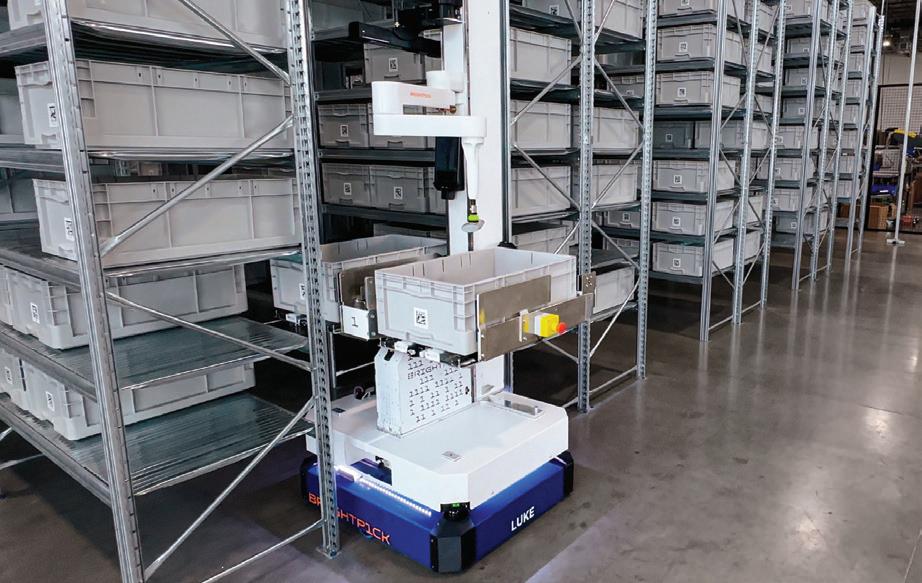
“The serious breakthroughs enable machine learning to generalize to unseen items.”
Other companies recognized for warehouse systems included Amazon Robotics, Exotec, Geek+, Instock, KUKA, Mujin, Sereact, and Simbe Robotics. Not only does this demonstrate the demand in this sector, but also the potential of automating new applications.
Electric Sheep named Startup of the Year
Every year, we see robotics startups with promising technologies shut their doors for good. It’s often very difficult to find funding to keep the business running while iterating on a robot and demonstrating its value to new customers.
However, San Francisco-based Electric Sheep’s unique business model allows it to bring in revenue as it takes
Superior encoders for position and motion control
With a comprehensive line up of encoder solutions, Renishaw brings the expertise needed to address your manufacturing challenges. Whether your application calls for optical, magnetic or laser technology, our encoders achieve the highest levels of accuracy, durability and reliability. Powerfully positioned for innovative motion control.
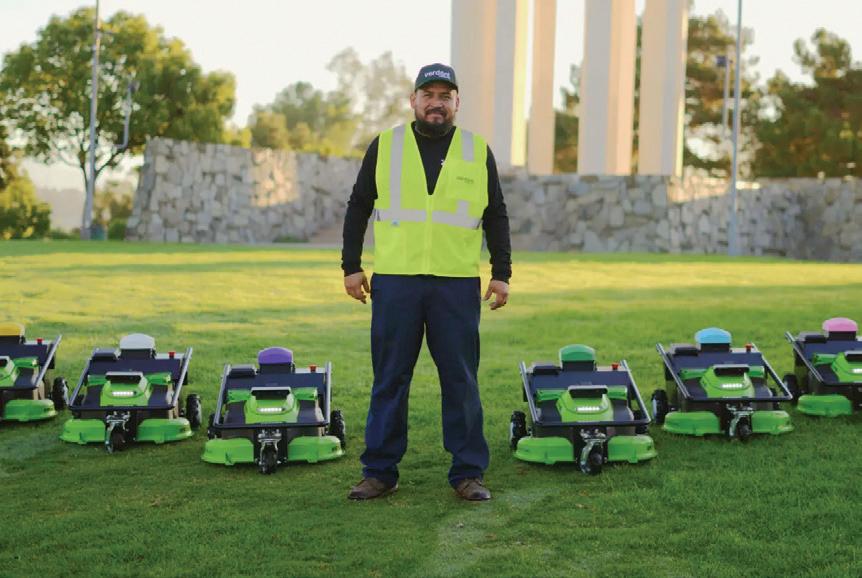

its time deploying its technology. This business model led to it being named Startup of the Year.
Electric Sheep develops autonomous robots for outdoor maintenance. Its flagship robot is an autonomous mower backed by the company’s ES1 foundation model. Instead of selling or leasing the robots to commercial landscaping businesses, Electric Sheep is becoming vertically integrated by purchasing landscaping companies. This allows it to get to know how these businesses operate and where the robots can best be





RBR50 iNTRODUCTION
partner for innovative manufacturing www.renishaw.com/encoders usa@renishaw.com Renishaw Inc., West Dundee, IL 60118 © 2024 Renishaw Inc. All rights reserved. See us at: Robotics Summit & Expo Booth #114
outdoor maintenance
Your
Brightpick’s Autopicker autonomous robots for

deployed while still bringing in revenue. Once Electric Sheep has decided where the robots can do the most work, its team can start integrating them into operations.
Since implementing this strategy, Electric Sheep said it has grown revenue by eight times. Last year, the company acquired four landscaping businesses, and it said this strategy is key to its longterm plan.
RBR50 winners innovate in several areas
In addition to humanoids, warehouse automation, and a new model for commercialization, this year’s RBR50 demonstrated the growing relevance of generative AI to robotics.
The availability of large language models (LLMs) like OpenAI’s ChatGPT is making new breakthroughs possible.


For example, Sereact released PickGPT, a robotics transformer that combines LLMs with the company’s computer vision technology. The technology allows robot operators to instruct the company’s pick-and-place robots using natural language. Agility Robotics and Boston Dynamics produced interesting demos using generative AI, while Toyota Research Institute is building large behavior models to enable robots to more quickly learn new tasks.
Other notable winners include Harvard University’s development of a soft exoskeleton that helped a 73-yearold man with Parkinson’s walk without freezing. And Seattle-based startup Glidance developed a robot that offers autonomous mobility assistance for the visually impaired. RR



SPONSORS
A NEW GENERATION OF ROTARY ENCODERS

Meet POSITAL’s Updated and Improved IXARC Encoders
New TMR sensor technology and upgraded processors offer enhanced performance and better energy efficiency.
Incremental encoders are programmable for extra versatility: Resolution and communications interfaces are can be easily customized to meet your exact requirements.
Muliturn absolute models feature updated Wiegand sensors and a new ASIC for optimized batteryfree rotation counting
More NEXTGEN product announcements coming soon!



5 THE ROBOT REPORT April 2024 www.therobotreport.com
www.posital.com
Editorial Director The Robot Report
Crowe Executive Editor The Robot Report
Wessling Associate Editor The Robot Report
Oitzman Editor The Robot Report
Eugene Demaitre
Steve
Brianna
Mike
Organization Category
ABB Robotics Application
Advanced Construction Robotics Application
Agility Robotics Robot of the Year
Amazon Robotics Technology
Ambi Robotics Technology
Apptronik Technology
Boston Dynamics Technology
Brightpick Application of the Year
Capra Robotics Application
Dexterity Application
Disney Technology
Doosan Technology
Electric Sheep Startup of the Year
Exotec Application
FANUC Business
Figure Technology
Fraunhofer Institute for Material Flow and Logistics Technology
Gardarika Tres Application
Geek+ Business
Glidance Application
Harvard University Application
ifm efector Technology
igus Technology
Instock Technology
Kodama Systems Application
Kodiak Robotics Application
KUKA Business
Locus Robotics Application
MassRobotics
Accelerator Business
Mecademic Technology
MIT Technology
Mujin Application
Mushiny Technology
Innovation
Modular industrial robot arms offer game-changing flexibility
IronBOT makes rebar installation faster, safer
Digit humanoid gets feet wet with logistics work
Amazon strengthens robotics portfolio with heavy-duty mobile robot
AmbiSort uses real-world data to improve picking
Apollo humanoid features bespoke linear actuators
Atlas shows off unique skills for humanoid
Autopicker applies mobile manipulation, AI to warehouses
Hircus AMR bridges gap between indoor, outdoor logistics
Dexterity stacks robotics and AI for truck loading
Disney brings beloved characters to life through robotics
App-like Dart-Suite eases cobot programming
Vertical integration positions landscaping startup for success
Skypod ASRS scales to serve automotive supplier
FANUC ships one-millionth industrial robot
Startup builds working humanoid within one year
evoBot features unique mobile manipulator design
Develops de-mining robot for Ukraine
Upgrades PopPick goods-to-person system
Provides independence to visually impaired individuals
Exoskeleton improves walking for people with Parkinson’s disease
Obstacle Detection System simplifies mobile robot development
ReBeL cobot gets low-cost, human-like hand
Instock turns fulfillment processes upside down with ASRS
Startup uses robotics to prevent wildfires
Autonomous pickup truck to enhance U.S. military operations
Robotic arm leader doubles down on mobile robots for logistics
Mobile robot leader surpasses 2 billion picks
Equity-free accelerator positions startups for success
MCS500 SCARA robot accelerates micro-automation
Robotic ventricle advances understanding of heart disease
TruckBot accelerates automated truck unloading
Intelligent 3D sorter ramps up throughput, flexibility
www.therobotreport.com 6 THE ROBOT REPORT April 2024

Organization Category
Mushiny Technology
NASA Technology
Neya Systems Technology
NVIDIA Technology
Olive Robotics Technology
OpenAI Technology
Opteran Technology
Renovate Robotics Application
Robel Application
Robust AI Technology
Rockwell Automation Business
Sereact Technology
Simbe Robotics Application
Slip Robotics Application
Symbotic Application
Toyota Research Institute Technology
ULC Technologies Application
Universal Robots Technology
Innovation
Intelligent 3D sorter ramps up throughput, flexibility
MOXIE completes historic oxygen-making mission on Mars
Development of cybersecurity standards harden AGVs
Nova Carter gives mobile robots all-around sight
EdgeROS eases robotics development process
LLMs enable embedded AI to flourish
Applies insect intelligence to mobile robot navigation
Rufus robot automates installation of roof shingles
Automates railway repairs to overcome labor shortage
Carter AMR joins DHL’s impressive robotics portfolio
Adds OTTO Motors mobile robots to manufacturing lineup
PickGPT harnesses power of generative AI for robotics
Scales inventory robotics deal with BJ’s Wholesale Club
Simplifies trailer loading/unloading with heavy-duty AMR
Walmart-backed company rides wave of logistics automation demand
Builds large behavior models for fast robot teaching
Cable Splicing Machine improve safety, power grid reliability
Cobot leader strengthens lineup with UR30
www.therobotreport.com 8 THE ROBOT REPORT April 2024


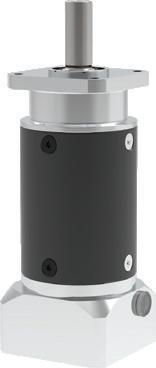

GAM’s broad range of standard robotic flange gearboxes, servo gearboxes, rack and pinion, and other automation products, along with our engineering expertise and manufacturing flexibility, provide the building blocks for the right solution to your specific application. GAM Can. ®
www.gamweb.com/custom | info@gamweb.com | 888.GAM.7117 Collaborate with GAM and make your job easier.
Miniature
Zero-Backlash,
Standard NEMA 17 Inline Planetary Gearbox Standard 35 mm Spiral Bevel Right Angle Gearbox Standard Size 017 Strain Wave Zero-Backlash Gearbox
- Customer Collaboration
Medical Robotics Application:
Right Angle,
Robotic Flange Gearbox
GAM
ABB modular industrial robot arms offer game-changing flexibility

ABB Robotics released its first modular industrial robot arms in 2023. Its fifth generation robots expanded the company’s large robot range with four new models. These models, however, include 22 different variants to offer ABB’s customers more choices, increased coverage, and greater performance.
The IRB 6710, IRB 6720, IRB 6730, and IRB 6740 have payloads ranging from 150 kg to 310 kg and reaches from 2.5 m to 3.2 m. What makes these robots innovative is that all 22 models are based on the same modular design. All of the components are standardized across all model platforms, including

Organization Name: ABB Robotics
Country: U.S.
Website: abb.com
Year Founded: 1974
Number of Employees: 500+
Innovation Category: Technology
the base, lower arm, upper arm, and wrist. All of the robots having the same footprint means installation is faster, more convenient, and more flexible.
All of the modules, or building blocks, share the same linkages or interfaces, allowing ABB to offer a greater range of robot models more efficiently. The company said these modules help it maintain a more manageable supply chain of components, allowing it to deliver builtto-order robots far more quickly and economically.
The result is shorter lead times for customers and more flexible robots. Customers can order an ABB robot
model that exactly matches the specifications of their application. And if things change in the future, they can simply change out robot components to modify the robot’s capabilities.
This lets ABB’s customers know they’re not sinking money into something that won’t be able to adapt as their business grows. For example, within the electric vehicle industry, manufacturers will likely need to ramp up production in the coming years. These manufacturers can choose from a wide range of ABB robots to ensure they have the right variant to handle batteries of varying sizes. RR

www.therobotreport.com 10 THE ROBOT REPORT April 2024


www.ids-imaging.us

IronBOT makes rebar installation faster, safer

Rebar is a steel bar used as a tension device in reinforced concrete or masonry. It’s an essential part of many construction projects, but it can be time-consuming and labor-intensive to install. According to OSHA, 61% of construction accidents are due, in part, to rebar.
Last year, Advanced Construction Robotics released its second rebarinstalling robot, IronBOT. While its first robot, TyBOT, self-ties horizontal rebar intersections, IronBOT lifts, carries, and places rebar. IronBOT can lift up to 5,000-lb bundles of rebar in a transverse or longitudinal orientation without requiring any heavy lifting from crew members.
IronBOT doesn’t require any preprogramming, pre-mapping, calibration, or BIM input. Once it’s on site, it can begin working within four to eight hours, the company claimed. It also automates rebar placement based on the customer’s spacing requirements.
IronBOT completed its inaugural project alongside TyBOT in February on the Port St. Lucie West Boulevard Bridge in Port St. Lucie, FL. The robots completed the project alongside Shelby Erectors, a construction company that specializes in building bridges.
The team originally estimated that rebar installation would take 14 days, but when augmenting Shelby’s crew with robots, the same amount of work took only seven days. During the pilot

Organization Name: Advanced Construction Robotics
Country: U.S.
Website: constructionrobots.com
Year Founded: 2016
Number of Employees: 1-10
Innovation Category: Application
project, IronBOT placed 147,032 lb of rebar, and TyBOT completed 58,068 ties over 6.5 production shifts.
IronBOT can work at any time of day or night, even in the rain. With the robot, workers can steer clear of rebar installations, ensuring their safety and
freeing them up to do higher-level tasks on the construction site. Its flexible design means it can work on almost any construction site and can be installed quickly, making it a potential gamechanging robot for the construction industry. RR

www.therobotreport.com 12 THE ROBOT REPORT April 2024










more
EXPO
Sponsorship opportunities are available for future DeviceTalks and Robotics programs. For
information, contact Colleen Sepich. 857.260.1360 | csepich@wtwhmedia.com SUMMIT &
DISCOVER THE LATEST ADVANCEMENTS IN
Agility Robotics’ Digit humanoid wins inaugural Robot of the Year Award
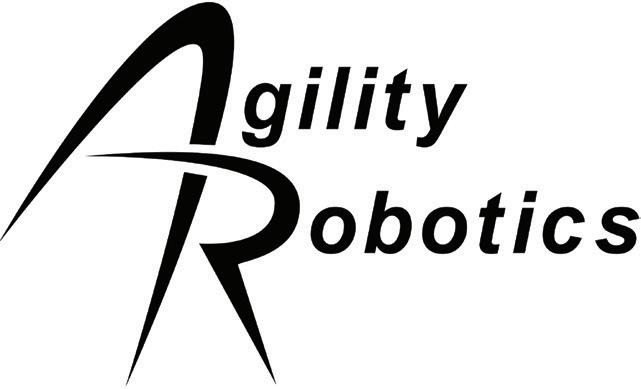
2023 was the year of humanoids, and it all started thanks to Agility Robotics. Its Digit humanoid stole the show at ProMat, where it demonstrated its ability to pick up totes from a shelf, walk over to a conveyor, and place the totes onto the conveyor.
At the time, Agility said the demo was based on a real customer use case. Later in 2023, Agility announced pilots with two major customers: Amazon and GXO Logistics, which claims to be the world’s largest pure-play contract logistics provider. Digit is 5 ft 9in (175cm) tall, weighs 143 lbs, and carries up to 35 lbs.
In October, Amazon and Agility announced Digit was being tested at Amazon’s robotics research and development facility outside of Seattle. The initial use of Digit is to help employees with tote recycling, a highly repetitive process of picking up and moving empty totes once inventory has been completely picked out of them.
In December 2023, GXO announced Digit is being tested on logistics tasks at a SPANX facility in Georgia. Digit is moving totes filled with products off of autonomous mobile robots (AMRs) and onto a conveyor. Agility said at the time that Digit will communicate with the AMR fleet manager in the future.
Adrian Stoch, GXO’s chief automation officer, said Digit’s potential flexibility gives it a nod over other types of robots, including AMRs with top

Organization Name: Agility Robotics
Country: U.S.
Website: www.agilityrobotics.com
Year Founded: 2015
Number of Employees: 101-500
Innovation Category: Robot of the Year
modules. “The real application here is end-to-end product flow throughout the warehouse,” he said. “Until now, solutions have been mostly discrete applications: goods-to-person, sorters, wearable tech. Solving discrete problems in one part of the puzzle.”
For companies operating fulfillment centers with a wide product mix or fluctuating demand, the potential
flexibility of humanoids could help fill the ongoing labor crisis.
We’ve never seen a humanoid perform real tasks in a commercial setting, until now. Humanoids have long been relegated to research labs, but the goalposts began to seismically shift in 2023. Congratulations to Agility Robotics for winning the inaugural Robot of the Year Award. RR

www.therobotreport.com 14 THE ROBOT REPORT April 2024
Amazon strengthens robotics portfolio with heavy-duty AMR mobile robot

Amazon is the world’s largest user of industrial robots. It has deployed more than 750,000 robots to help fulfill customer orders. According to the Seattle-based e-commerce giant, more than 75% of all customer orders globally are delivered with the help of robots.
That number is only going to increase going forward with the introduction of robots like Titan, Amazon’s new mobile robot. Titan can transport heavy-duty payloads up to 2,500 lb. (1,133.9 kg). That is two times more than Hercules, which is Amazon’s most broadly deployed mobile robot.
Organization Name: Amazon Robotics
Country: U.S.

Website: amazon.jobs/en/teams/amazon-robotics
Year Founded: 2003
Number of Employees: 501-1000
Innovation Category: Technology
Titan integrates several technologies from Amazon’s other mobile robots for battery management, computer vision, obstacle detection, and user control. It can also integrate with other robots Amazon uses throughout its facilities by using familiar hardware components to manage its operating system “as it plans, executes, and interfaces with other technologies.”
Amazon said its SAT1 fulfillment center in San Antonio, Texas, is the first to deploy Titan. It will work with other robots to move heavy objects, including small household appliances or pallets of pet food and gardening equipment, and allow
people to focus on new tasks.
While there are other heavy-duty mobile robots on the market, Amazon developing and deploying Titan in its facilities proves these robots are ready for primetime. Titan increases the number of SKUs Amazon can move via robotics, meaning it could be another game-changing robot for Amazon, joining the likes of Hercules, Pegasus, Proteus, Robin, and more. Titan is a continuation of Amazon’s decades of robotics research to better serve its customers and create a better workplace for its employees. RR

15 THE ROBOT REPORT April 2024 www.therobotreport.com
Ambi Robotics leverages real-world data for more flexible picking solution

Ambi Robotics released its AmbiSort B-Series in 2023, an updated version of its flagship robot with some impressive new features. With robots deployed across the U.S. in over a dozen states, and running through the entire 2022 peak holiday season, Berkeley, Calif.based Ambi Robotics was able to leverage the extensive real-world data it gathered to add new capabilities to AmbiSort.
AmbiSort B-Series is the company’s entry into automated induction, middlemile sortation, and reverse logistics. The new sort-to-gaylord system can handle up to 1,200 sorts per hour. Additionally, it can be used in various use cases,

Organization Name: Ambi Robotics
Country: U.S.
Website: ambirobotics.com
Year Founded: 2018
Number of Employees: 101-500
Innovation Category: Technology
such as reverse logistics, zone skipping, and AI-vision quality control, making it one of the more configurable systems available in today’s market.
This new system is built around the AmbiSort bin-picking capabilities the company introduced with its previous A-Series robot. It includes an industrial robot, an overhead vision system, and AI-driven perception software.
All of Ambi Robotics’ solutions run on its proprietary operating system, AmbiOS. This system teaches robots in simulation and transfers its deep neural network advancements to physical world systems by leveraging breakthroughs in Sim2Real technology.
The company makes its system even more robust with AmbiAccess. This platform comes with a suite of operation-enhancing applications to make customers’ lives easier. This new customer portal doesn’t just provide data visibility, it gives customers comprehensive insights and advanced analytics and leverages historical data and trends.
In all, Ambi Robotics’ AmbiSort B-Series builds on the company’s already successful system to provide customers with more flexibility, more capabilities, and a better understanding of their current operations. RR

www.therobotreport.com 16 THE ROBOT REPORT April 2024
Apptronik releases humanoid robot with bespoke linear actuators

In August 2023, Apptronik released Apollo, the company’s first commercial version of a bipedal humanoid robot. Apptronik is no stranger to the development of legged robotics, having built multiple generations of exoskeletons for the U.S. defense department.
These projects helped the company develop the kinematics, mechanical and electrical expertise to support the venture into bipedal robotics.

Organization Name: Apptronik
Country: U.S.
Website: apptronik.com
Year Founded: 2016
Number of Employees: 101-500
Innovation Category: Technology
The company's primary intellectual property is linear actuation. Apollo includes several linear actuators for its leg and arm joints. Apollo uses linear actuators for joints such as the elbow and knee, in contrast to competitors who have opted for rotary motors and gear trains.
By offering a sixth generation of motors, Apptronik has surpassed rivals like Tesla in this area. Not only does this improvement make things cheaper,
it also makes the supply chain more reliable and the manufacturing process more scalable, which is important for expanding Apollo's uses beyond factories. Building a low-cost linear actuator is a big step forward for Apptronik that will make this growth possible. RR

17 THE ROBOT REPORT April 2024 www.therobotreport.com
Atlas demo unique manipulation, mobility skills for humanoid

With all the momentum around commercializing humanoids, it seems many have forgotten about Boston Dynamics’ Atlas. The prototype has always served as an R&D platform, with certain technologies eventually making their way into the company’s other robots, Spot and Stretch.
In January 2023, Boston Dynamics released a video showing Atlas performing a task at a mock construction site inside its Waltham, Mass. headquarters. A “construction worker” atop a scaffold left his toolbag on the ground. Instead of hopping down to get the tools himself, Atlas brings the tools to him.
Atlas, using a claw gripper, picks up and manipulates a wooden plank to create a bridge for itself onto the scaffold. It then picks up a toolbag, runs onto the scaffold, spins around, and throws the toolbag up to the construction worker. Atlas then pushes a wooden box off the scaffold and flips and twists its way to the ground.
“The dream of humanoids is that they should be able to do all the things that we do, right?” Scott Kuindersma, Boston Dynamics’ team lead on Atlas, said in a behind-the-scenes video about the construction site demo. “A humanoid robot will be well suited for applications like manufacturing, factory work, construction - [places] where a humanoid form factor actually fits very

Organization Name: Boston Dynamics
Country: U.S.
Website: www.bostondynamics.com
Year Founded: 1992
Number of Employees: 101-500
Innovation Category: Technology
well, with its bi-manual nature, its ability to stand upright, move heavy things around, and work in spaces that were traditionally designed for humans to do work in.”
At press time, Boston Dynamics hadn’t disclosed any plans to
commercialize Atlas. But this video, and many previous ones, should be a reminder about Atlas’ leading mobility and manipulation skills. And if a commercial version of Atlas ever comes to market, it’d likely jump to the front of the pack. RR

www.therobotreport.com 18 THE ROBOT REPORT April 2024
Autopicker applies mobile manipulation and AI for warehouse flexibility
Organization Name: Brightpick
Country: U.S.
Website: brightpick.ai
Year Founded: 2021
Number of Employees: 101-500
Innovation Category: Application of the Year

Each picking and mobile manipulation have been challenging for robotics developers. In 2023, Brightpick unveiled Autopicker, which it said is the first commercially available autonomous mobile robot (AMR) that can pick and consolidate orders directly in warehouse aisles.
Autopicker combines a mobile platform, a robotic arm, machine vision, and artificial intelligence for e-commerce fulfillment. The innovative system’s patented two-tote design enables it to retrieve orders from bins on shelving and pick items to one of its totes. This reduces the need for associates to spend time traveling with carts.
The robot can fulfill orders for everything from cosmetics and pharmaceuticals to e-grocery items, electronics, polybagged apparel, and spare parts. To do this, Autopicker uses proprietary 3D vision and algorithms trained on more than 500 million picks, as well as machine learning to improve over time.
Based in Cincinnati, Brightpick is a business unit of machine vision provider Photoneo.
“On the AI side, this was not possible five to six years ago,” Jan Zizka, co-founder and CEO of Brightpick, told The Robot Report. “The serious breakthroughs enable machine learning to generalize to unseen items.”
Brightpick also offers a goods-toperson option for heavy or hard-to-pick items. Autopicker can raise its bins to waist height for ergonomic picking.
By working with standard shelves, the AMR can be deployed in less than a month, and warehouses can reconfigure storage as needed. The system also supports pallet picking, replenishment, dynamic slotting, buffering, and dispatch. It can store up to 50,000 SKUs.
Last year, Brightpick went from raising additional funding to deploying Autopicker at Netrush, Rohlik Group, and other customers. The system is available for direct purchase or through a robotics-as-a-service (RaaS) model. RR

19 THE ROBOT REPORT April 2024 www.therobotreport.com
Capra Robotics bridges gap between VELUX’s indoor, outdoor logistics
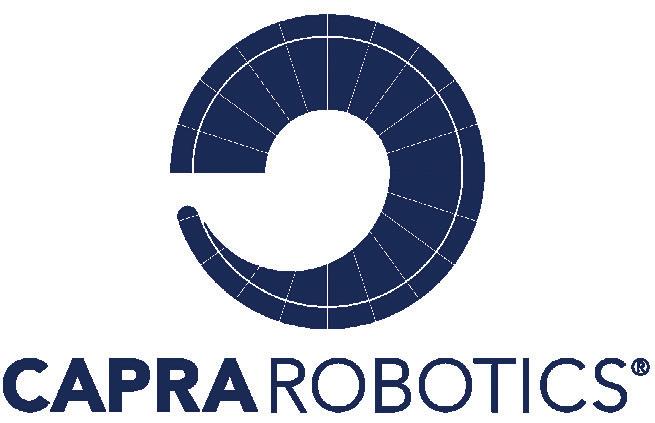
Capra Robotics introduced the Capra Hircus, an autonomous mobile robot (AMR) designed to navigate challenging terrain with ease, thanks to its patented kinematic model and four-wheel chassis. This robot can carry various types of loads while moving across rough and uneven surfaces.
The Hircus AMR has the unique

Organization Name: Capra Robotics
Country: Denmark
Website: capra.ooo
Year Founded: 2019
Number of Employees: 11-50
Innovation Category: Application
keep it on its path. The system uses cameras for obstacle detection and avoidance.
VELUX, a Danish window manufacturer, had the challenge of transporting payloads and material weighing up to 500 kg within and between their manufacturing facilities in Skjern, Denmark. The company sought a unified solution to address this issue.
The Capra Hircus, in combination with a detachable cart solution from partner ROEQ, proved to be the ideal
fit for VELUX's requirements. The Capra solution has been incorporated into current operations, with tasks from the central management system sent to the robot through the Capra Fleet Manager using the standardized VDA5050 interface.
Workers can stage and queue raw materials, work in process, and finished goods on the carts, and then schedule the robots to pick and move between manufacturing areas.

The movement process is completely automated as the robot autonomously controls gates and doors along the way, giving them access to the outside world, and then back indoors once they arrive at their destination.
VELUX said it sees immense potential in bridging the gap between indoor and outdoor transport. It added that integrated gate control, automated pick-up and drop-off, and wireless charging were among the reasons Hircus was the obvious solution to this end. RR
www.therobotreport.com THE ROBOT REPORT April 2024
Dexterity stacks robotics and AI for truck loading

Loading trucks and trailers is a thankless task, requiring workers to repeatedly move boxes of all sizes. Dexterity Inc. has been working with FedEx Corp. and Sagawa Express Co., among others, to automate this process.
Truck unloading requires people or robots to pick from the top and work their way down. By contrast, loading is like “playing 3D Tetris with up to 50-lb. boxes,” said the Redwood City, Calif.based company.
Dexterity has developed DexR, a two-armed robot that uses machine vision, force sensing, and integrated motion planning to pick up a range of items, from stiff cardboard to soft plastic. The mobile system also uses machine learning to get better at packing trailers over time.
The system can autonomously drive in and out of trailers as it loads or unloads. DexR does not require presequencing to stack boxes into stable walls, the company said.
“Based on feedback from our operations team, we have been looking for a solution that helps alleviate the challenges of truck loading,” stated Rebecca Yeung, corporate vice president of Operations Science and Advanced Technologies at FedEx. “Collaborating with Dexterity AI to combine the latest in AI and robotics

Organization Name: Dexterity
Country: U.S.
Website: dexterity.ai
Year Founded: 2017
Number of Employees: 101-500
Innovation Category: Application
supports our operations team while meeting growing customer demand.”
Dexterity noted that DexR integrates with existing warehouse doors and conveyors, and it can operate at speed in tight spaces. The company said it has built on its experience in singulation and induction, palletization and depalletization, and robotic print and apply.
In addition, Dexterity provides fleet management and data analytics capabilities. It is working with Sumitomo as a distributor for its robotics-as-aservice (RaaS) offering in Japan, with a goal of deploying 1,500 systems by 2026. RR

21 THE ROBOT REPORT April 2024 www.therobotreport.com
Disney develops new approach for building robotic characters

Disney Research has long been at the intersection of imagination and cuttingedge technology. And it outdid itself again in late 2023 when it unveiled a new robot that wandered through Disneyland California’s Star Wars: Galaxy’s Edge. The robot didn’t have a name yet at press time, but it seems to be inspired by the BD-1 from the Star Wars Jedi: Fallen Order video game.
Moritz Bächer, associate lab director at Disney Research in Zurich, led development of the robot. It combines modular hardware, learning software, and 3D printing. The robot’s head has four degrees of freedom to look up, down, around, and tilt. It also has five degree-of-freedom legs with hip joints that allow it to walk while dynamically balancing.
And the robot can do more than walk. Disney Research engineers and Walt Disney Imagineering Research & Development animators worked closely together to ensure that it can convey emotions by strutting, prancing, or trotting around. To do this, the company developed a reinforcement learning-based pipeline that relies on simulation to combine and balance the vision of an animator with legged locomotion.
Disney is exploring how its robotic characters can enhance the park experience for customers. And these recognizable, charismatic robots could be just the tip of the iceberg.

Organization Name: Disney Research
Country: U.S.
Website: disneyresearch.com
Year Founded: 2008
Number of Employees: 101-500
Innovation Category: Technology
Disney’s researchers said its new development techniques should significantly reduce the time needed to train a robot on new behaviors. Bächer claimed Disney can now develop new robotic characters in months rather than years.
We’ve never seen robots like these before, but we could soon start seeing more robotic versions of Disney’s most beloved characters interacting with us in its parks. RR

www.therobotreport.com 22 THE ROBOT REPORT April 2024
Doosan Robotics’ app-like DartSuite eases cobot programming
Organization Name: Doosan Robotics
Country: South Korea
Website: www.doosanrobotics.com
Year Founded: 2015
Number of Employees: 101-500
Innovation Category: Technology

How is a robot like a smartphone? Both are platforms that can be programmed for multiple tasks. However, mobile apps allow users to tap into a wide range of activities, while robots typically require experienced engineers for specialized applications by industry. By contrast, Doosan Robotics’ Dart-Suite aims to provide a “holistic and democratized environment for users of all types.”
The robot ecosystem is intended to enable users of collaborative robots to download an app, install it, and use it, all without prior expert knowledge. DartSuite allows for multitasking.
For example, a coffee shop could use a single cobot to act as a barista in
the morning, prepare lunch menus at midday, and serve beer as a bartender in the evening. In addition, Dart-Suite allows robots to be used across fields, such as food and beverage, logistics, agriculture, and manufacturing.
Doosan noted that Dart-Suite, which it developed last year, has an integrated development environment (IDE) that allows customers to create modules for their specific needs. The IDE includes drag-and-drop artificial intelligence functionality to reduce the time of development by as much as 80%, as well as to cut the cost of integration.
While many robots today get software updates through wired connections or
USB, Dart-Suite provides over-the-air (OTA) updates for easier management of operating systems and software.
The company developed a recycling system with Dart-Suite that it dubbed “Oscar the Sorter,” which was later recognized by the Consumer Technology Association. TDK Qeexo applied machine learning and vision plus the compliant grippers to materials handling.
Dart-Suite can increase the range and number of tasks that cobots can do, expanding the number of industries that can deploy automation. RR

23 THE ROBOT REPORT April 2024 www.therobotreport.com
Vertical integration positions Electric Sheep for long-term success

Every year, we see robotics startups with promising technologies shut their doors for good. It’s often very difficult to find funding to keep the business running while iterating on a robot and demonstrating its value to new customers.
However, San Francisco-based Electric Sheep’s unique business model
Organization Name: Electric Sheep
Country: U.S.
Website: sheeprobotics.ai
Year Founded: 2019
Number of Employees: 51-100
Innovation
Category: Startup of the Year
allows it to bring in revenue as it takes its time deploying its technology. This business model led to it winning our inaugural Startup of the Year Award.
Electric Sheep develops autonomous robots for outdoor maintenance. Its flagship robot is an autonomous mower backed by the company’s ES1 foundation model. Based on recent


advances in generative AI, ES1 is a learned-world model that enables reasoning and planning for the company’s robots.
Instead of selling or leasing the robots to commercial landscaping businesses, Electric Sheep is becoming vertically integrated by purchasing the landscaping companies. This allows Electric Sheep to get to know how these businesses operate and where the robots can best be deployed while still bringing in revenue. Once it’s decided where the robots can do the most work, the team can start integrating them into operations.
Electric Sheep’s strategy isn’t just about revenue. The businesses it acquires can provide crucial data used to make ES1 more effective. And because this data will be coming from businesses that ES1 will be at work in, the company’s robots can start working from the moment they hit the ground.
Since implementing this strategy, Electric Sheep said it has grown revenue by eight times. Last year, it acquired four landscaping businesses, and it says this strategy is key to its long-term plan. By ensuring that the startup always has revenue coming in, and finding a unique way to acquire essential industry-specific data, Electric Sheep has set itself apart from other startups. RR
www.therobotreport.com 24 THE ROBOT REPORT April 2024
Exotec Skypod ASRS scales to serve automotive supplier’s SKU volume

Many warehouse operators are struggling with increasing complexity, and recent innovations in automation promise to help them adapt and scale their businesses. Exotec has developed the Skypod modular hardware and software for flexible storage and picking.
Lane Automotive provides highperformance automotive parts and accessories. The Watervliet, Mich.based company carries more than 660 bands, stocks over 100,000 SKUs in its distribution center, and offers more than 2.2 million parts from its catalog that serves four primary sales channels.
Lane Automotive needed to exceed fulfillment deadlines to meet carrier pickup times. It also needed to handle a

Organization Name: Exotec
Country: France
Website: www.exotec.com
Year Founded: 2015
Number of Employees: 500+
Innovation Category: Application
wide range of products and ease worker strain.
“The seasonal nature of our business generally sees its peaks between March and June,” said James MacEachern, chief operating officer of Lane Automotive. “This volume could stress our operational capacity.”
Last year, Exotec deployed Skypod to help Lane Automotive modernize fulfillment operations, building on its experience in the grocery, retail, e-commerce, and third-party logistics (3PL) markets.
“What was unique about this deployment is that Lane carries a lot of SKUs for very specific needs - racing, drag racing, and off-road - but it has
small inventories for each,” said Stanislas Normand, managing director of Exotec North America. “That’s where Skypod creates value instead of standard warehouse fulfillment solutions.”
The automated storage and retrieval system (ASRS) uses robots to move goods between high-density storage racks and ergonomic picking stations.
Skypod has streamlined inventory tracking, reduced the need for Lane Automotive employees to walk five to seven miles per day, and eliminated the need for heavy lifting since products are now picked directly into their shipping cartons. The company said it expects to see at least a sixfold increase in throughput. RR

25 THE ROBOT REPORT April 2024 www.therobotreport.com
FANUC ships one-millionth industrial robot

FANUC has been a pioneer in automation and robotics for nearly 50 years. And in August 2023, it reached another milestone with the shipment of its one-millionth industrial robot. The robot sold was a FANUC R-2000iC/210F that is designed to lift heavy payloads up to 210 kg in a variety of applications.
FANUC developed its first robot in 1974, called “FANUC ROBOT MODEL 1." FANUC used the robot on its own production line. Today, FANUC offers 200+ industrial and cobot models that are used in production facilities worldwide to assemble, handle, package, paint, and weld products of every shape and size.
FANUC uses its own robots to make robots, controllers, and machine tools to give itself a leg up on some of its competitors. "When customers visit FANUC’s headquarters in Japan, they are amazed to see the highly automated assembly lines and leave feeling confident in our ability to solve their production problems,” the company has said.
This landmark sale highlights FANUC's commitment to quality and reliability over the years, earning the trust of manufacturers worldwide to help drive their businesses forward. FANUC’s robots have consistently delivered exceptional performance, efficiency, and durability, setting the standard for excellence in robotics.
This milestone also reflects the role robotics plays in modern manufacturing. Robots from many companies have revolutionized production processes across a range of industries. By automating repetitive tasks, streamlining operations, and improving efficiency, Fanuc’s robots empower manufacturers to enhance productivity, reduce costs, and stay competitive in today's dynamic marketplace. RR
Organization Name: FANUC
Country: Japan
Website: www.fanuc.com
Year Founded: 1958
Number of Employees: 500+
Innovation Category: Business


www.therobotreport.com 26 THE ROBOT REPORT April 2024
Figure AI builds working humanoid within 1 year

Organization Name: Figure AI
Country: U.S.
Website: www.figure.ai
Year Founded: 2022
Number of Employees: 11-50
Innovation Category: Technology

Since exiting stealth mode in January 2023, Sunnyvale, Calif.-based Figure AI has swiftly navigated toward commercializing a humanoid under the leadership of founder and CEO Brett Adcock, a seasoned entrepreneur with two successful startups behind him.
Figure’s team includes industry veterans like CTO Jerry Pratt from IHMC, who boasts 20-plus years of experience developing humanoids. The company has also hired employees from Apple, Auris, Boston Dynamics, Nimble Robotics, Rivian, Tesla, and other leading technology companies.
The blistering development path that Figure demonstrated throughout the year is a testament to building and equipping a top-notch team with the right tools to be successful.
The company achieved dynamic bipedal walking with its Figure 01 humanoid in less than one year, which the company claims to be one of the quickest turnarounds in humanoid history. Figure 01 features dexterous manipulation capabilities and, like other humanoid developers, is being designed for logistics applications such as tote moving as potential tasks early on.
During a visit in October 2023, The Robot Report observed Figure’s meticulous approach to product prototyping and sophisticated development infrastructure, highlighting the team's prowess in iterative design and debugging. The integration of a fully dissected robot for software development and electrical system troubleshooting underscores the depth of expertise within Figure's ranks, showcasing the company's maturity despite its relative youth.
Starting in October, the company began to show progress through key milestones, including manipulation tasks, untethered walking, and real work demonstrations. RR

27 THE ROBOT REPORT April 2024 www.therobotreport.com
evoBot offers unique design for autonomous mobile robots

evoBOT is the kind of robot that stands out the moment you look at it. Its unique and seemingly simple design doesn’t resemble any other autonomous mobile robot (AMR) on the market today. Designed at the Fraunhofer Institute for Material Flow and Logistics, the robot consists of two wheels and gripper arms. If you’re looking at it head-on while it’s zooming around without any cargo, the robot simply looks like an arch with wheels attached at the bottom.
The robot uses these arms to grip boxes by applying pressure from each side, and it maintains balance as it zips across airports. It keeps its balance using a dynamically stable system based on the principle of an inverted pendulum, which means it doesn’t have an external counterweight. Its ability to balance makes it able to move on different and uneven surfaces.
evoBOT can reach a maximum speed of up to 60 km/hour (around 37 MPH) and can transport a load of up to 100 kg (over 220 lbs). It can handle hazardous goods, transport parcels for longer recurring distances, relieve employees during lifting and overhead work, procure materials, and provide support during the loading and unloading of an aircraft.
Last year, evoBOT completed its first test run at the Munich Airport. There, it performed a practical test in the cargo terminal and on the apron of the airport. These tests further proved how versatile the system is, setting it up for potential deployments in numerous industries. evoBOT’s innovative design sets it apart from its AMR counterparts, and it has the capabilities to back that up. RR
Organization Name: Fraunhofer Institute for Material Flow and Logistics
Country: Germany

Website: www.iml.fraunhofer.de/en/fields_of_ activity/material-flow-systems/iot-andembedded-systems/evobot.html
Year Founded: 1981
Number of Employees: 500+
Innovation Category: Technology

www.therobotreport.com 28 THE ROBOT REPORT April 2024
Ukrainian tractor automation company develops demining robot

Ukraine-based Gardarika Tres is a manufacturer and distributor of agricultural equipment that focuses on precision farming systems and was founded in 2014. The company started an autonomous tractor navigation brand called Efarm.pro in 2023.
At the end of January 2023, according to reports, about 250,000 square kilometers of Ukrainian agricultural land had become a minefield.
These explosive devices must be cleared from the fields. However, there is a lack of trained personnel and appropriate equipment to do the job. Accelerating the demining process will provide an opportunity to quickly restore the country's economy, industry, and agrarian entrepreneurship, and save people's lives.
The Efarm.pro brand developed an unmanned system to remove mines from fields. The system includes a drone, an autonomous tractor, and a demining attachment that can withstand explosions. The demining solution is driven remotely from a safe distance to ensure there are no humans in harm’s way.
The demining solution scans the field with a drone equipped with appropriate sensors to target demining areas. These areas are subsequently defused by running the autonomous tractors together with certified sappers. The innovation with the solution is to employ a mature autonomous navigation system for tractors with a hardened mine sweeper to explosively remove any mines within a field and return it to productive growing for farmers.
The tractor is equipped with additional armor plates, designed for use in vehicle structures for mine protection and improvised explosive devices. This ensures that the solution can work its way through the field without the need to stop and repair after a mine is set off. RR
Organization Name: Gardarika Tres
Country: Ukraine
Website: efarm.pro/demining_ukraine
Year Founded: 2014
Number of Employees: 11-20
Innovation Category: Application


29 THE ROBOT REPORT April 2024 www.therobotreport.com
Geek+ upgrades goods-to-person system
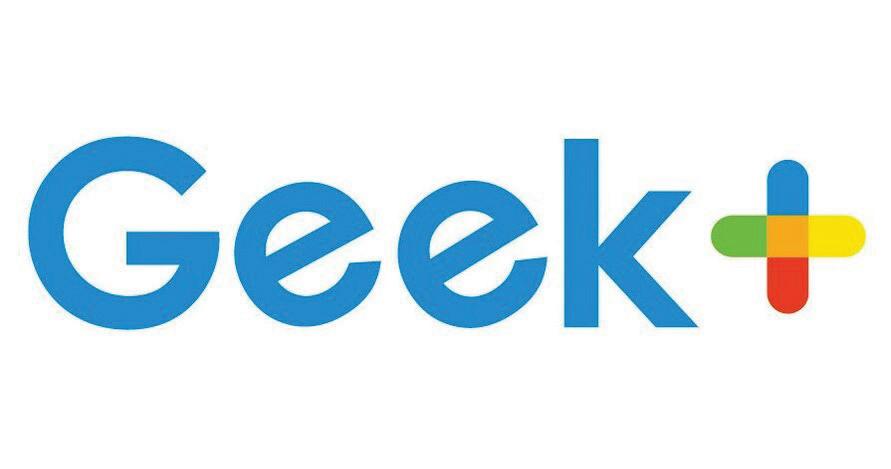
Geek+ unveiled its latest PopPick mobile robotics solution for order fulfillment in early 2023. PopPick's upgraded goods-to-person system offers mobility and versatility, eliminating infrastructure investments. With the capacity to handle goods of all sizes, it optimizes order fulfillment for third-party logistics providers (3PLs) and retailers, addressing the surge in e-commerce demands.
The system, built around autonomous mobile picking robots, achieves automatic docking of order containers, presenting goods to operators for efficient picking. PopPick boasts impressive metrics, including up to 650 totes picked per hour, a 50% increase in warehouse storage density, and doubled throughput capacity. Geek+ said its solutions prioritize safety and scalability, with modular designs allowing for easy expansion during peak seasons.
3PLs have embraced PopPick as a solution that prioritizes high-density storage with high picking efficiency, as well as variable storage locations and rapid storage location alterations. The PopPick system helps retailers manage a large number of SKUs with different sizes and order frequencies. With its tailored solutions, PopPick enhances business-to-consumer and businessto-business choices across a variety of sectors.

Organization Name: Geek+
Country: U.S.
Website: www.geekplus.com
Year Founded: 2015
Number of Employees: 101-500
Innovation Category: Technology
Geek+'s commitment to R&D ensures continual innovation, catering to diverse industry needs. More than 1,000 global customers, including Fortune 500 clients, attest to the company’s market leadership. The adoption of mobile robotics not only enhances efficiency but also empowers workers, supplementing labor during shortages and enabling faster fulfillment.
As supply chains evolve, mobile robotics offer agility and flexibility, facilitating quick adjustments and efficient inventory management. PopPick epitomizes this shift towards automation, providing intuitive solutions that improve workforce productivity and optimize order fulfillment, ultimately securing a competitive advantage in today's dynamic market landscape. RR

www.therobotreport.com 30 THE ROBOT REPORT April 2024
Glidance provides independence to visually impaired individuals

In the United States, around one million adults are blind. Yet, only 2 to 8% use a white cane for navigation. Most instead rely on guide dogs or sighted companions, according to the Perkins School for the Blind. This reliance limits independence and mobility, a challenge Glidance, winner of the 2023 RoboBusiness Pitchfire Competition, aims to address through robotics.
The company’s flagship product, Glide, offers autonomous mobility assistance for the visually impaired, incorporating advanced guiding technologies and a unique mechanical design to foster independence. Providing haptic and audio feedback for safety, Glide's innovation garnered praise from industry experts, particularly for its potential to serve an underserved market segment. CEO Amos Miller, himself blind, brings a firsthand perspective to Glidance's mission.
Organization Name: Glidance
Country: U.S.
Website: glidance.io
Year Founded: 2023
Number of Employees: 2-10
Innovation Category: Application


The company plans to sell the device for about the cost of a new cell phone and offer subscription plans that enable feature updates and options that will make Glide easily configurable for each user's needs. With a battery life of up to eight hours and quick user adaptation, Glide promises to revolutionize mobility for the visually impaired. Founded by Miller and Mike Sinclair, Glidance represents hope for those seeking greater freedom and autonomy in navigating the world.
Miller noted that more than 50,000 individuals lose their sight every year, yet worldwide there are only 10,000 working guide dogs any year, leaving a huge gap and providing the opportunity for a device like Glide to make a huge difference in users' lives. It can cost up to $50,000 annually to train and care for a guide dog throughout its working lifetime with a person who is blind. RR

31 THE ROBOT REPORT April 2024 www.therobotreport.com
Exoskeleton improves walking for people with Parkinson’s disease


Organization Name: Harvard John A. Paulson School of Engineering and Applied Sciences
Country: U.S.
Website: seas.harvard.edu
Year Founded: 2007
Number of Employees: 500+
Innovation Category: Application
Researchers at Harvard John A. Paulson School of Engineering and Applied Sciences developed a soft exoskeleton to help a person with Parkinson’s walk without freezing. Freezing of gait (FOG) is a common, yet poorly understood, symptom of Parkinson's disease. It causes sudden and involuntary episodes of immobility that can occur during walking, often leading to falls and injuries. Traditional treatments for FOG, such as medication adjustments and physical therapy, have had limited success.
The researchers spent six months working with a 73-yearold man with Parkinson’s disease who, despite using both surgical and pharmacologic treatments, endured substantial and incapacitating FOG episodes more than 10 times a day. These episodes prevented him from walking around his community and forced him to rely on a scooter to get around outside.
The exoskeleton uses cable-driven actuators and sensors worn around the waist and thighs. Using motion data collected by the sensors, algorithms estimate the phase of the gait and generate assistive forces in tandem with muscle movement.
Without any special training, the patient was instantly able to walk without any freezing indoors and with only occasional episodes outdoors. He was also able to walk and talk without freezing, a rarity without the device.
Harvard collaborated on this with Boston University. The researchers said “this work suggests the potential benefits of a ‘bottom-up’ rather than ‘top-down’ solution to treating gait freezing. We see that restoring almost-normal biomechanics alters the peripheral dynamics of gait and may influence the central processing of gait control.”
The research demonstrates the potential of exoskeletons to treat FOG and offers hope to those with Parkinson’s disease. It could help them regain their mobility and independence. RR

www.therobotreport.com 32 THE ROBOT REPORT April 2024
ifm simplifies mobile robot development with Obstacle Detection System

ifm efector’s Obstacle Detection System tackles the toughest hurdles of integrating 3D cameras into mobile robots, streamlining development, and reducing both capital expenditure and total cost of ownership. This increases a user’s return on investment and could help to democratize mobile robots, particularly for small and medium-sized enterprises (SMEs).
While mobile developers have effectively addressed person detection with standard safety LiDARs, collisions with objects beyond their view remain a challenge, potentially causing damage and hindering mission efficiency. Both automated guided vehicles (AGVs), which navigate using static path planning, and autonomous mobile robots (AMRs), which navigate using dynamic path planning, react differently to detected obstacles. However, both grapple with potential collisions. 3D cameras can offer a comprehensive solution, affording a complete view of the robot's path.
The ifm Obstacle Detection Solution reduces mobile

Organization Name: ifm efector
Country: U.S.
Website: www.ifm.com/us/en
Year Founded: 1985
Number of Employees: 101-500
Innovation Category: Technology
robot development time by providing a ready-made option for manufacturers, ensuring integration across diverse environments, and reducing facility integration time, irrespective of floor conditions.
Although mobile robots are gaining popularity as a tool to enhance workforce efficiency and address labor shortages, they have not yet achieved widespread adoption. ROI is one factor holding mobile robots back. Addressing this requires a shift in focus towards total cost of ownership (TCO), with significant development and deployment times emerging as the primary impediments.
By offering an obstacle detection solution priced at just $450 per robot, without recurring fees, ifm provides a viable “buy” option for developers and aims to redefine affordability and performance benchmarks for mobile robots. This approach enables manufacturers to concentrate on delivering value to end-users, catalyzing the integration of mobile robots into SME companies.RR


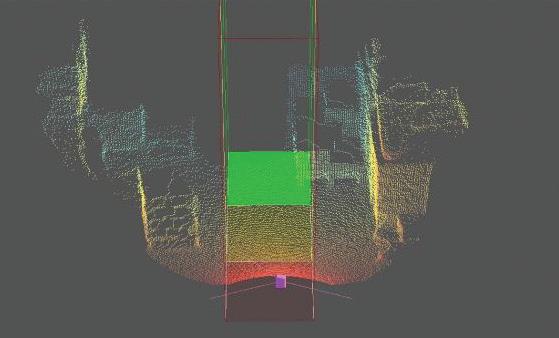
33 THE ROBOT REPORT April 2024 www.therobotreport.com
igus gives ReBeL cobot a low-cost, human-like hand


Organization Name: igus GmbH
Country: Germany
Website: www.igus.com
Year Founded: 1964
Number of Employees: 500+
Innovation Category: Technology
For all of the strides made in humanoid locomotion over the past year or so, there are still numerous applications for robotic manipulation to address. igus offers a finger gripper for its ReBeL collaborative robot arm to help developers.
The company designed ReBeL with its self-lubricating iglide plastics to be low-cost and easy to integrate so that innovators could focus on building the next generation of robots. End-of-arm tooling is already available for tasks such as assembly or inspection through the RBTX.com marketplace.
“As the ReBeL is very light and inexpensive with a weight of around 8 kg [17.6 lb.] and a price starting at $6,899, it is often used in humanoid applications,” said Alexander Mühlens, head of the low-cost automation business unit at igus. “For this reason, we have received several customer requests for a robot hand that can be easily connected to the ReBeL via plug and play.”
igus, whose U.S. headquarters are in Rumford, R.I., added that extensive testing has proved the longevity and flexibility of its hand. The ReBeL finger gripper can be controlled via various interfaces, including USB, TTL (5V) serial, and internal scripting.
The new end effector is compatible with all ReBeL models and is controlled by digital I/O at the tool center point. It can also copy human motion in teleoperation or imitation-learning applications.
The dexterous hand could be useful in university research, food service, and the entertainment industry. Small and midsize enterprises, which are already adopting collaborative robots for their ease of programming, can try to automate new tasks with low risk.
Following igus’ policy of openly listing its prices, the ReBeL finger gripper is available for $2,760. RR

34 April 2024
www.therobotreport.com THE ROBOT REPORT
Instock turns fulfillment processes upside down with unique ASRS

Instock came onto our radar when it became part of the Amazon Industrial Fund’s portfolio of robotics investments. This is the same fund that invested in Agility Robotics and many other notable companies.
Instock is taking a unique and flexible approach to automated storage and retrieval systems (ASRS). Most of these systems involve complex racking that moves bins around and places them onto autonomous mobile robots (AMRs) that bring those bins to picking robots or human pickers.
Instock doesn’t take this approach. Instead, the only moving part within the system is the AMRs, which pick up the bins themselves by gripping the bin wings and bringing them to workstations.
To travel between levels and maximize space, Instock’s AMRs drive along curved ramps placed at the end of the company’s modular racks. The AMRs then use magnets to drive upside down along the ceiling of the rack. When on the ceiling, the robot places itself above a bin and grabs from the top with its unique gripper. The AMRs can then use the ramps to travel to whatever level they need to be at to deliver the bin to picking stations. The AMRs use the same system to bring bins back to the racks.
Because the only moving part within the entire system is the AMRs, Instock’s ASRS is easy to fix when things go wrong. Similar systems might require the entire ASRS to be shut down while repairs are made to one module, but with Instock, users simply need to remove the malfunctioning robot for maintenance. Instock’s unique ASRS is more flexible and could require less maintenance than traditional systems. RR
Organization Name: Instock
Country: U.S.
Website: instock.com
Year Founded: 2020
Number of Employees: 11-50
Innovation Category: Technology


35 THE ROBOT REPORT April 2024 www.therobotreport.com
Kodama Systems uses robotics to prevent wildfires

In 2022, wildfires burned over 7.5 million acres of land in the U.S., according to the National Centers for Environmental Information. It’s a pressing issue in the U.S., and it will only get worse as the climate becomes hotter and drier.
While there are some robots deployed to fight these deadly wildfires, few are working to prevent them. This is where Kodama Systems comes in.
Historically, forests in the U.S. were less dense than they are today. Overstocked forests have resulted in greater competition for resources among plant life in these areas, making them more vulnerable to drought and other stressors. Scientific consensus also

Organization Name: Kodama Systems
Country: U.S.
Website: kodama.ai
Year Founded: 2021
Number of Employees: 1-10
Innovation Category: Application
suggests that these overgrown forests are a key contributor to the current wildfire crisis. An abundance of smaller, often weaker, trees is ready to burn.
To combat this overgrowth, government agencies have been increasingly investing in initiatives aimed at thinning out these forests. This is a labor-intensive task, as it requires a number of heavy machines to drive into the forest, cut down the trees, and then haul them out so they can be cut to size and delivered to sawmills to be processed.
Kodama Systems is working to add autonomy to the process. It creates teleoperation and autonomy kits for
the heavy machinery at work. The team started with the skidder, a piece of equipment used to haul cut-down trees out of the forest.
In 2023, the company deployed its teleoperation platform on a small forestthinning project in the Stanislaus National Forest. During this project, the company’s skidder autonomously dragged bundles of trees along skid trails to the project landing. In all, Kodama Systems creates technology for the labor-intensive and crucial work of thinning forests to prevent wildfires. RR

www.therobotreport.com 36 THE ROBOT REPORT April 2024
Autonomous pickup truck could enhance U.S. military operations

Kodiak Robotics unveiled in late 2023 its first autonomous test vehicle for the U.S. Department of Defense (DoD). A Ford F-150 truck is outfitted with Kodiak's autonomous system, Kodiak Driver, and is designed to handle complex military environments, diverse operational conditions, and areas with degraded GPS, as well as off-road variables like rocks, dust, mud, and water. The F-150 can be teleoperated if needed.
Since its founding in 2018, Kodiak has primarily focused on developing autonomous trucks. But the road to scaling autonomous vehicles has turned out to be longer than many expected.

Organization Name: Kodiak Robotics
Country: U.S.
Website: kodiak.ai
Year Founded: 2018
Number of Employees: 101-500
Innovation Category: Application
Working with the military could be a quicker path to revenue for Kodiak, which won a two-year, $50 million contract with the Army in December 2022.
Kodiak said it took less than six months to build the autonomous Ford F-150. If all goes well for Kodiak, it could become one of the Army’s future technology partners.
The Ford F-150 introduces new possibilities for enhancing military logistics and operations. Unmanned transportation of supplies and personnel offers the military greater flexibility, efficiency, and safety in fulfilling its mission-critical objectives.
This work also highlights the importance of a modular, vehicleagnostic autonomous driving system. The F-150 runs the same software as Kodiak's autonomous long-haul trucks and features Kodiak DefensePods, an adapted version of Kodiak's swappable SensorPods.
Kodiak Robotics said finding multiple use cases for its autonomous driving system is key to its future.
“Finding applications of technology that can apply to military use simultaneously with civilian and commercial use cases is the future. That’s where the efficiency is. That’s where the iteration is.” RR

37 THE ROBOT REPORT April 2024 www.therobotreport.com
KUKA releases next generation of mobile robots

KUKA has been a leading provider of industrial robot arms for years. It has also dabbled in the mobile robotics space. But in late 2023 it added some serious punch to its mobile robot portfolio.
KUKA introduced three new mobile robots in 2023: the KMR iisy mobile cobot, KMP 1500P, and KMP 600-S diffDrive. The new iisy model is a mobile manipulator that includes the LBR iisy cobot with a payload capacity of 11-15 kg and a mobile platform that can carry a supplementary load of up to 200 kg.

Organization Name: KUKA
Country: Germany
Website: kuka.com
Year Founded: 1898
Number of Employees: 500+
Innovation Category: Business
The KMP 1500P is built for heavy-duty applications and can transport up to 1.5 tons of material, while the new KMP600S model can move payloads of up to 600 kg.
KUKA’s AMRs are designed for a range of sectors, including the manufacturing, logistics, and automotive industries. Some of its older models are omnidirectional to ensure maximum freedom of movement and highprecision transport even with heavy loads. The company’s AMRs come with advanced sensor technology, no-code
programming, state-of-the-art battery technology, and higher energy density.
KUKA joins a long list of companies with strong mobile robotics portfolios. But KUKA is more of a household name than many of its competitors. And, again, it seems to be more serious about mobile robots with its “new AMR generation.” With these new models, KUKA continues to set itself apart from most other robotics providers by being a true one-stop shop for automation. RR

www.therobotreport.com 38 THE ROBOT REPORT April 2024
Locus Robotics surpasses 2 billion picks with AMRs

In August 2023, autonomous mobile robot (AMR) developer Locus Robotics surpassed 2 billion picks for its warehouse fulfillment customers. The milestone came just 11 months after it surpassed the 1 billion pick mark in 2022, for which it also won an RBR50 Robotics Innovation Award.
"Achieving the two billion picks milestone is an incredible accomplishment for our company and for our customers," said Rick Faulk, CEO, Locus Robotics. “This event is a testament to the dedication and innovation of our incredible team and the dramatic productivity improvements we deliver to drive our customers’ growth and success.”

Organization Name: Locus Robotics
Country: U.S.
Website: locusrobotics.com
Year Founded: 2014
Number of Employees: 51-100
Innovation Category: Application
It took Locus just 358 days to go from 1 billion to 2 billion, with the last 100 million picks taking just 27 days. That’s an average of 3.7 million picks per day. By comparison, it took more than six years to make the first billion picks and 1,542 days to pick the first 100 million units.
“Locus’ consistent innovation, usercentric approach, and genuine dedication to customer relationships put them at the forefront of warehouse automation,” said Alan McDonald, vice president of continuous improvement, GEODIS. “This milestone is a testament to its technological leadership and synergistic collaboration. We look forward to building
on our work together and driving even greater efficiency improvements in the future.”
Warehouse operators are increasingly turning to AMRs to meet growing demand and overcome labor shortages. And Locus Robotics continues to lead the way. Its AMRs support more than 120-plus of the world's top brands and are deployed at 300-plus sites globally. Locus enables retailers, 3PLs, and specialty warehouses to efficiently meet and exceed the increasingly complex and demanding requirements of today's fulfillment environments. RR

39 THE ROBOT REPORT April 2024 www.therobotreport.com
MassRobotics Accelerator positions startups for success

MassRobotics is the world’s first and largest independent non-profit innovation hub focused on growing robotics technology companies, scaling solutions, and championing robotics adoption. The MassRobotics Accelerator, Powered by Mass Tech Collaborative, empowers the next generation of robotics startups through non-dilutive funding, custom tailored curriculum, and personalized mentorship.
This is the first accelerator of its kind with equity-free programming committed to supporting and advancing robotics technology entrepreneurs and technical founders through a 13-week, in-person program based out of the MassRobotics headquarters in Boston. Mentors and

Organization Name: MassRobotics
Country: U.S.
Website: www.massrobotics.org
Year Founded: 2015
Number of Employees: 11-50
Innovation Category: Business
technical experts participating in the program include well-known robotics experts and entrepreneurs who are providing first-hand experience to help guide the 10 selected companies participating in the program.
The 10 startups include Apparel Robotics, brd BOT, Gopher Motion, Hominid X, Mapless AI, Oligo, Robotics 88, rStream, SIMPL Automation, and Yard Robotics.
These companies have access to world-class prototyping facilities as well as manufacturing experts who mentor companies on scaling. This is the first public/private accelerator of its kind.
More than 140 startups applied to this program, with applicants representing
more than 25 countries. The selection process was robust, ending with a selection committee composed of notable roboticists, entrepreneurs, and academics.
“Technical founders can often jump to product-building mode before intimately understanding their end user and customer. During this program, our startups will each complete at least 25 customer discovery interviews, in an effort to hone in on their customer pain and needs,” said Marita McGinn, director of the MassRobotics Accelerator. “Our goal is to help these brilliant technical founders bolster their business acumen through this curriculum.” RR
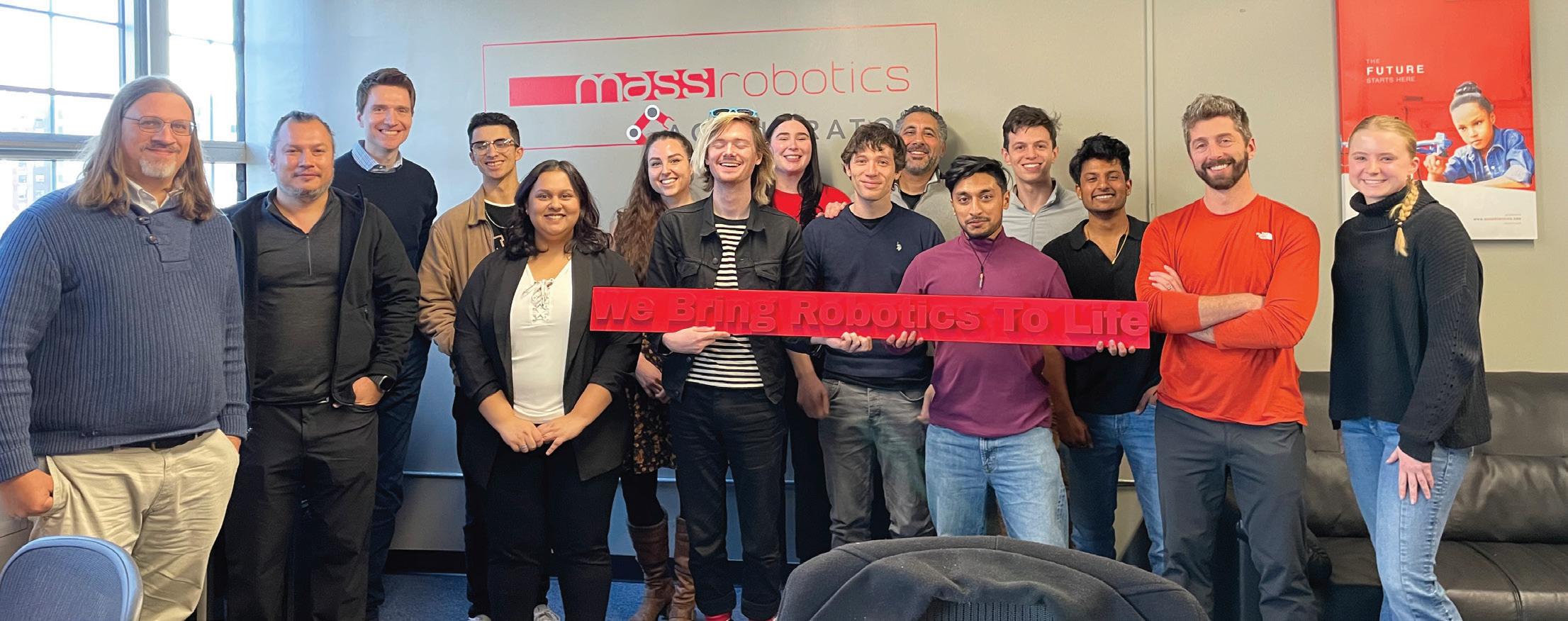
www.therobotreport.com 40 THE ROBOT REPORT April 2024
Mecademic accelerates microautomation with SCARA robot


Organization Name: Mecademic
Country: Canada
Website: www.mecademic.com
Year Founded: 2013
Number of Employees: 11-50
Innovation Category: Technology

Mecademic launched its micro-SCARA robot in 2023, offering high speed and repeatability in a small and flexible format. The new tabletop SCARA follows the Mecademic tradition of developing high-quality, high-precision, smaller-footprint robots for assembly applications in electronics and healthcare. Mecademic has carved out a niche in the industrial robotics market with two of the tiniest yet fully capable robots on the market today.
The new MCS500 SCARA robot boasts repeatability of 0.005 mm. It features an embedded controller in the base of the robot and eight digital I/O and various communication ports, simplifying integration possibilities. The robot can be programmed with Mecademic’s software or integrated with any other robot control software. Mecademic robot arms include external 24/36V power supplies and are equipped with embedded safety modules, E-Stops and a safety I/O interface.
This industrial robotic innovation fills a crucial gap in the automation market amidst the growing trend towards miniaturization, and will create a strong demand across various industries where space is a premium. Mecademic claims the MCS500 is the world's most compact and most precise SCARA robot with a reach of 225 mm and a maximum payload of 1 kg (2.2 lbs).
With fast cycle times and mounting flexibility, the MCS500 is ideal for a variety of applications. It can be mounted on a table or hung from an overhead mounting platform, depending on the application requirements. This robust robot is unique in that it offers a combination of simplicity, precision, and high performance in a small package. RR
41 THE ROBOT REPORT April 2024 www.therobotreport.com
Robotic ventricle advances understanding of heart disease

MIT engineers developed a robotic replica of the heart’s right ventricle that mimics the beating and blood-pumping action of live hearts. The robotic right ventricle (RRV) combines real heart tissue with synthetic, balloon-like artificial muscles. It allows scientists to control contractions and observe the function of natural valves and structures.
The right ventricle is one of the heart’s four chambers, but its anatomical complexity has made it difficult for clinicians to accurately observe and assess its function in patients with heart disease.
Researchers said the RRV serves as a platform to study right ventricle disorders and test cardiac devices, providing insights into conditions such as right ventricular dysfunction, pulmonary hypertension, and myocardial infarction. They also said conventional tools often fail to capture the intricate mechanics and dynamics of the right ventricle, leading to potential misdiagnosis and inadequate treatment strategies.
MIT has also demonstrated the model's potential as a training tool for surgeons and cardiologists by implanting mechanical valves and ring-like medical devices to repair or replace malfunctioning valves. With plans to extend its performance and test implantable devices, the RRV represents a significant advancement in understanding and treating heart disease.

Organization Name: Massachusetts Institute of Technology
Country: U.S.
Website: www.mit.edu
Year Founded: 1861
Number of Employees: 500+
Innovation Category: Technology
The RRV currently simulates realistic heart functions over a few months. The team is working to extend that performance and enable the model to run continuously for longer stretches. They are also working with designers of implantable devices to test their prototypes on the artificial ventricle and possibly speed their path to patients.
In the future, the researchers aim to pair the RRV with a similar artificial, functional model of the left ventricle, which the group is currently fine-tuning. RR

www.therobotreport.com 42 THE ROBOT REPORT April 2024
Mujin TruckBot accelerates automated truck unloading

Robots are moving from the factory and warehouse floor out to the loading dock. Mujin said its TruckBot system can unload up to 1,500 cases per hour.
“TruckBot is a game-changer for warehouses looking to streamline their operations and reduce costs,” stated Ross Diankov, CEO of Mujin, when the system was launched at ProMAT 2023.
“The dock door is the largest bottleneck in our supply chain, and unloading trailers is back-breaking work,” he added. “TruckBot will improve safety and effectiveness for warehouses across the globe while unlocking the possibility for fully autonomous operations.”

Organization Name: Mujin
Country: Japan
Website: www.mujin-corp.com
Year Founded: 2011
Number of Employees: 51-100
Innovation Category: Application
TruckBot can handle everything from boxes weighing up to 50 lb. to mixed-SKU loads, said Suwanee, Ga.based Mujin, which also has offices in China, Japan, and the Netherlands. The company has been developing TruckBot for more than six years.
Suction grippers with multiple channels allow for opportunistic multipicking, and an integrated conveyor maximizes throughput, said Mujin. The telescoping TruckBot can reach up to 52 ft. into a truck trailer or a shipping container.
In addition, the company said its MujinController planning software provides precision and flexibility for
complex unloading scenarios. With it, TruckBot can autonomously make decisions in real time, handling different package types and load configurations, said Mujin.
“Machine intelligence is the combination of the digital twin, realtime control, motion planning, and perception,” Diankov told The Robot Report. “These four components allow a machine to reason about its surroundings in a predictable way and to complete tasks in an optimal way.”
The company first expanded into North America in 2021, continued its European expansion last year, and finalized Series C extension funding in December. RR
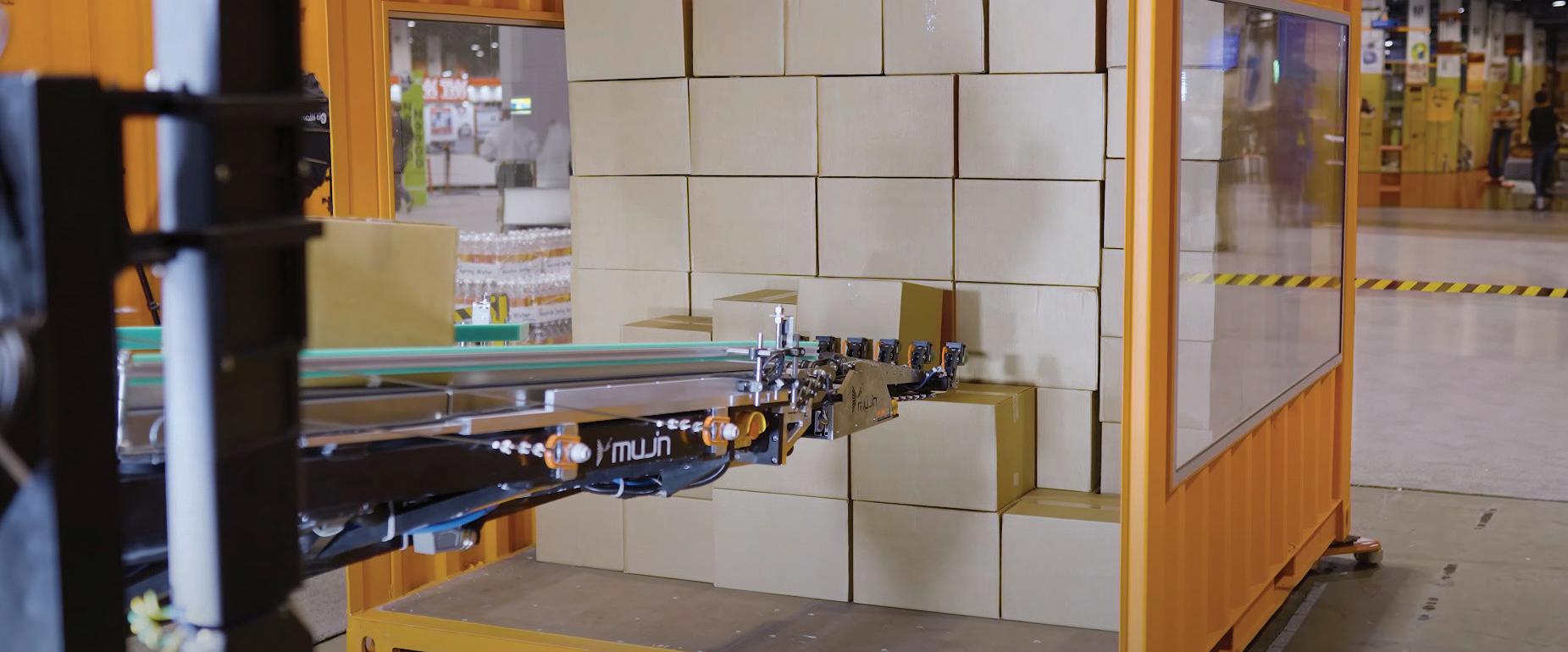
43 THE ROBOT REPORT April 2024 www.therobotreport.com
Mushiny ramps up throughput, flexibility with Intelligent 3D Sorter

Manual sortation and fulfillment of orders often rely on putwalls and other techniques for short-term storage and conveyance. Mushiny’s Intelligent 3D Sorter automates the picking process and enables warehouse operations to grow their batch or wave sizes.
Spikes in e-commerce demand, sorting of soft-bagged goods or fragile items, and the need to trace foods or pharmaceuticals throughout production and logistics all pose challenges to supply chains.
By combining an automated carousel with mobile racks of totes and human picking, Mushiny’s system increases the amount of order lines picked per POD

Organization Name: Mushiny
Country: China
Website: www.mushiny.com
Year Founded: 2016
Number of Employees: 101-500
Innovation Category: Technology
or tote presentation. Adding one to four infeed lines to the 3D Sorter allows it to handle a wide range of items and reduces the number of robots required.
Released in November 2023, the Intelligent 3D Sorter includes three innovations: an elevated sorting efficiency, a high degree of flexibility, and an optimized return on investment (ROI). The Suzhou, China-based company said its peak efficiency is more than 10,000 picks per hour.
The system can do both horizontal and vertical sorting to increase putorder efficiency by over 200%, and improve pick order efficiency by more than 300%. It can be integrated with
warehouse management systems and other production software, and it features a compact and modular design for ease of deployment and maintenance.
Mushiny cited a fashion company with a wide product range or SKU count as a typical customer. The Intelligent 3D Sorter could fulfill many orders concurrently, as robots continuously transfer completed orders and buffer them as needed before dispatching. The combination of robots and human pickers could increase retail and e-commerce productivity, as well as efficiently process returns. RR

www.therobotreport.com 44 THE ROBOT REPORT April 2024
MOXIE completes historic oxygen-making mission on Mars

The Mars Oxygen In-Situ Resource Utilization Experiment (MOXIE) generated oxygen for the 16th and final time aboard NASA’s Perseverance Rover on August 7, 2023. The microwave-sized device surpassed all expectations from its creators at both NASA JPL and the Massachusetts Institute of Technology (MIT).
After Perseverance landed on Mars on Feb. 18, 2021, MOXIE generated 122 grams of oxygen, which is about what a small dog breathes in 10 hours, NASA said. At its most efficient, MOXIE produced 12 grams of oxygen per hour

Organization Name: NASA JPL
Country: U.S.
Website: jpl.nasa.gov
Year Founded: 1936
Number of Employees: 500+
Innovation Category: Technology
at a purity of 98% or better. This is twice as much as NASA’s original goal for the instrument. On its final run, MOXIE made 9.8 grams of oxygen.
MOXIE produces molecular oxygen through an electrochemical process that separates one oxygen atom from each molecule of carbon dioxide pumped in from Mars’ thin atmosphere. As the gases flow through the system, they’re analyzed to check the purity and quantity of the oxygen produced.
Devices based on the technology at work in MOXIE will be key for future missions. It seems obvious that astronauts
who could someday find themselves on Mars will need an oxygen source to breathe, but NASA has other uses in mind. In particular, the technologies inside MOXIE could serve as a source of rocket propellant, which will be required in industrial quantities to launch rockets with astronauts for their return trip home.
During its time on Mars, MOXIE completed all of its technical requirements and lasted through the varying conditions of a full Mars year. It performed the first-ever demonstration of an oxygen-producing system on the Red Planet. RR

45 THE ROBOT REPORT April 2024 www.therobotreport.com
Neya Systems developing cybersecurity standards for AGVs

In November 2023, Neya Systems started developing a cybersecurity standard for autonomous ground vehicles (AGVs). The effort focuses on enhancing the protection, mitigation, recovery, and adaptability of AGVs. It will do this by applying Department of Defense Zero Trust cybersecurity to its autonomy software.
Neya Systems aims to push its autonomy software beyond existing automotive security. To manage this task, the company says it will use the Autonomous Intelligent Cyberdefense Agent (AICA) reference architecture to apply cyber extensions to its Mission Planning and Management Software.
The company is currently developing, training, and testing its

Organization Name: Neya Systems
Country: U.S.
Website: neyarobotics.com
Year Founded: 2009
Number of Employees: 51-100
Innovation Category: Technology
new cybersystems using its Virtual Integration and Simulation Environment. Neya Systems said this will enable it to safely develop new capabilities and demonstrate viability thousands of times before it starts field testing.
“By introducing and managing zero trust principles for autonomy in vehicles, Neya Systems is paving the way for safer and more secure transportation systems,” Kurt Bruck, division manager of Neya Systems, said. “We are excited to be focused on developing technology that will establish a more secure future for our ground and autonomous vehicles. Our team is committed to delivering fully functional cyber autonomy that will help protect the safety and security of our nation’s
commercial and defense-related transportation systems.”
The company’s goal for cyber autonomy is to intelligently identify threats and risks to autonomous missions. It is designed to be completely self-contained and capable of autonomously detecting, reporting, and defending against threats that can exploit or disrupt a mission. By implementing a suite of behavioral analytics to baseline an expected, normal state-of-vehicle operation, it can then leverage anomaly detection techniques that will act as the “intelligent” subsystem. RR

www.therobotreport.com 46 THE ROBOT REPORT April 2024
NVIDIA gives mobile robots allaround sight with Nova Carter

The development of commercial-grade mobile robots is a time-consuming process, but Santa Clara, Calif.-based NVIDIA wants to accelerate that process with the Nova Carter platform. It enables surround vision for autonomous navigation, freeing developers to focus on other applications for artificial intelligence in robotics.
Selecting, integrating, and calibrating sensors - not to mention developing necessary device drivers - can take years. Released in October 2023, Nova Carter is a fully functional autonomous mobile robot (AMR) that can help streamline development.
The AMR provides out-of-the-box support for capabilities including 3D mapping, visual simultaneous localization and mapping (vSLAM), and stereo-based depth estimation. Nova Carter also provides global localization, AI-based object detection and segmentation, and more for factory or warehouse operations.
It is powered by the Nova Orin reference architecture, which integrates the Segway RMP Lite 220 differential drive, NVIDIA Jetson AGX Orin for accelerated computing with ROS 2, and a suite of cameras and lidar sensors for 360-degree perception.
In addition, Nova Carter’s sensors offer a data rate of more than 800 megapixels per second. It includes the sensor drivers and initialization software to configure the robot, as well

Organization Name: NVIDIA
Country: U.S.
Website: www.nvidia.com
Year Founded: 1993
Number of Employees: 500+
Innovation Category: Technology
as systems to calibrate the cameras to the lidar.
Not only does Nova Carter support 3D mapping, but it also provides ROS 2 packages for operation with Nav2. A digital twin model in Isaac Sim enables software-in-the-loop and hardware-inthe-loop testing.
NVIDIA boasted that Nova Carter increases high-resolution perception by 12x through time-synchronized color
sensors. The platform will help robotics developers drive further innovation across industries.
NVIDIA is offering Nova Carter with partner Segway-Ninebot, which provides robots for indoor and outdoor deliveries, intralogistics, inspection, and cleaning. RR

47 THE ROBOT REPORT April 2024 www.therobotreport.com
Olive Robotics eases robotics development with EdgeROS

Olive Robotics unveiled a gamechanging innovation for mobile robotics with EdgeROS, an approach that integrates the power of Robot Operating System 2 (ROS 2) and Data Distribution Service (DDS) directly into System on Modules (SoMs). This integration marks a significant leap forward in robotic system integration, promising enhanced sensor and motor control capabilities and paving the way for sophisticated and adaptable robotic solutions.
The cornerstone of EdgeROS lies in its integration of ROS 2's computational and communication capabilities into hardware modules. Unlike ROS 1, ROS 2 excels in real-time processing, catering to the deterministic execution times crucial in robotic applications such as motion control and autonomous navigation. This is made possible through real-time operating system (RTOS) compatibility, realtime-safe memory management, and deterministic execution of middleware layers.
The amalgamation of ROS 2 and DDS within SoMs promises to improve AMR development. This advancement facilitates more sophisticated navigation algorithms, improved obstacle detection and avoidance, and enhanced operational efficiency, ultimately leading to enhanced levels of autonomy.

Organization Name: Olive Robotics
Country: Germany
Website: www.olive-robotics.com
Year Founded: 2020
Number of Employees: 2-10
Innovation Category: Technology
Olive Robotics' commitment to innovation extends beyond EdgeROS. With advanced embedded AI sensors, Olive Robotics simplifies sensor intelligence, enabling robots and automation systems to perceive, learn, and react more efficiently. With a 100x improvement in accuracy and speed, Olive's technology is a game-changer for the development of new mobile robotic solutions.
The development of ROS on Module by Olive Robotics represents a significant advancement by providing improved functionalities in real-time processing, dependable communication, and streamlined
system integration. The development of techniques to optimize bandwidth, maintain interoperability, and manage latency is crucial for expanding the capabilities of robotic systems, especially in the domains of automated guided vehicles (AGVs), autonomous mobile robots (AMRs), and service robots. RR

www.therobotreport.com 48 THE ROBOT REPORT April 2024
OpenAI enabling embedded AI to flourish

OpenAI is a software company focused on artificial intelligence (AI) research. Its mission is to ensure the benefits of AI are accessible to all of humanity. OpenAI has created a number of large language models (LLM) and image generation models that could revolutionize a number of technologies, including robotics.
ChatGPT has sparked an innovation race that is finding its way into many robotic solutions. Not only can ChatGPT generate viable software code, but its APIs are also being integrated by robotics manufacturers to demonstrate the ability of a robot to understand and parse voice instructions.

Organization Name: OpenAI
Country: U.S.
Website: openai.com
Year Founded: 2015
Number of Employees: 101-500
Innovation Category: Technology
In one demo in 2023, Agility Robotics integrated its Digit humanoid with ChatGPT. The only voice command given to the robot was, “Hey Digit, clean up this mess.” Digit hears the command and uses an LLM to interpret how best to perform the task. At no point is Digit instructed on how to clean or told what a mess is, according to Agility Robotics. The company said this is an example of bridging the conversational nature of ChatGPT and other LLMs to generate real-world physical action.
In another demo, Boston Dynamics integrated its Spot quadruped with ChatGPT to generate multiple interactive “personalities” for the robot.
Spot took on the voice of a British butler, a Shakespearean actor, a pirate, and a sarcastic teenager.
For the entire robotics industry, the availability of large language models like ChatGPT is making new and unanticipated breakthroughs possible and accelerating the entire robotics industry forward faster than anticipated.
OpenAI’s development of ChatGPT has demonstrated the potential of LLMs. Numerous software and AI companies, from Google and Amazon to untold startups, are exploring and building out generative AI capabilities. RR

49 THE ROBOT REPORT April 2024 www.therobotreport.com
Opteran applies insect intelligence to mobile robot navigation

Current approaches to machine autonomy require a lot of sensor data and expensive compute and still frequently fail when exposed to real-world edge cases. The company earned RBR50 recognition in 2021 for its lightweight Opteran Development kit, which took inspiration from research into insect intelligence.
In December 2023, Opteran commercialized its vision-based approach to autonomy by releasing Opteran Mind. The company, which has offices in London and Boston, claimed that its new algorithms don’t require training, extensive infrastructure, or connectivity for perception and navigation.
This is different from other AI approaches and simultaneous

Organization Name: Opteran
Country: U.K.
Website: opteran.com
Year Founded: 2019
Number of Employees: 11-50
Innovation Category: Technology
localization and mapping (SLAM), which are based on decades-old models of the human visual cortex, said James Marshall, a professor at the University of Sheffield and chief scientific officer at Opteran. Animal brains evolved to solve for motion first, not points in space, he noted.
Instead, Opteran Mind can run with low-cost, 2D CMOS cameras and on low-power compute for nondeterministic path planning. OEMs and systems integrators can build bespoke systems on the reference hardware for mobile robots, aerial drones, and other devices.
“We provide I/O for collision prediction and robust output for panoramic, stabilized 3D visualization,” explained Marshall.
At a recent live demo in Boston, Opteran showed how a simple autonomous mobile robot (AMR) using Opteran Mind 4.1 could navigate and avoid obstacles in a mirrored course that would normally be difficult for other technologies.
The company is currently focusing on AMRs for warehouses, saying, “We have the only solution that provides robust localization in challenging environments with scene changes, aliasing, and


www.therobotreport.com 50 THE ROBOT REPORT April 2024
Renovate Robotics puts Rufus to work on roofs

In the near future, robots could be a common sight on rooftops. Renovate Robotics is developing a robot to autonomously install both asphalt and solar roof shingles. The application opportunity includes both new home construction and refurbishment opportunities. Roofs typically need to be redone every 20-30 years.
In 2023, the company introduced its first product, named Rufus, as an automated roofing robot that installs traditional asphalt shingles at a rate three times faster than a human roofer. The robot is designed to reduce labor requirements by half, increase worker safety, and improve unit economics for roofing contractors.
With over 80 million single-family homes in the United States and over 1 million new homes built each year, the demand for roofing is increasing. There is also a shortage of skilled labor to safely install roofing materials. Working on the roof is also a dangerous occupation.
The robot operates using a winchbased system. It is attached to the roof and travels in a gantry-like X and Y axis pattern, placing and securing shingles as it moves. Renovate is exploring various strategies to generate revenue from the technology, all while enhancing the system.
Renovate Robotics plans to initially operate as a subcontractor, using its

Organization Name: Renovate Robotics
Country: U.S.
Website: www.renovaterobotics.com
Year Founded: 2021
Number of Employees: 1-10
Innovation Category: Application
technology to complete jobs with partner roofing contractors. Long term, the company expects to lease its machines to roofing contractors in a robotics as a service (RaaS) model, allowing them to double productivity
and improve unit economics. Renovate Robotics secured pre-seed funding in a March 2023 round to develop the first working units, and the company is planning to begin field trials in 2024. RR

51 THE ROBOT REPORT April 2024 www.therobotreport.com
ROBEL automating railway repairs to overcome labor shortage

Crumbling transportation infrastructure is a serious concern worldwide. In March 2023, FANUC noted that ROBEL Rail Automation developed a system to repair rails and points, or movable track sections, using its industrial robot arms.
"We are seeing high demand from our customers for fully automated, robot-assisted maintenance systems," stated Thomas Weis, head of development at ROBEL Rail Automation. “This is especially true for the time-consuming and complicated repair work of points. Here, rail network operators are increasingly lacking skilled workers such as welders.”
Labor and skills shortages are

Organization Name: ROBEL Rail Automation
Country: Germany
Website: railautomation.com/en
Year Founded: 2022
Number of Employees: 11-50
Innovation Category: Application
particularly severe in the transport sector, with hundreds of thousands of miles of tracks to inspect, maintain, and repair just in Europe and North America.
The 2021 Bipartisan Infrastructure Law authorized $1.1 trillion in federal spending on transportation, energy, and climate infrastructure modernization projects. Some of those funds could be used to procure systems, including railway repair robots.
ROBEL Rail Automation has been developing ROBOT for automated switch maintenance and ROSPECT for self-propelled detection of rail defects.
ROBEL’s system uses two FANUC arms hanging from a special rail car.
The robots can detect defects with ultrasound equipment, cameras, and systems for measuring eddy currents. FANUC said the sensors and its arms ensure consistent-quality work.
It shares data on needed repairs with customers. The Robel Rail Automation System can then automatically make complex repairs using welding, milling, and grinding processes.
ROBEL showed off its technology during a factory open house in Freilassing, Germany, in September. European transport networks are currently running the prototype systems, which ROBEL expects to make commercially available in two to three years. RR

www.therobotreport.com 52 THE ROBOT REPORT April 2024
Robust AI deploying Carter AMR with DHL


Organization Name: Robust AI
Country: U.S.
Website: robust.ai
Year Founded: 2019
Number of Employees: 11-50
Innovation Category: Technology
DHL Supply Chain, a global leader in contract logistics, uses a variety of robots to solve challenges inside warehouses. Most notably, it uses autonomous mobile robots (AMRs) from Locus Robotics and the Stretch trailerunloading system from Boston Dynamics. DHL conducts extensive tests on a variety of other robots, but only a small fraction successfully pass these rigorous pilots.
DHL recently announced its partnership with Robust AI, a startup founded by Rodney Brooks, Henrik Christensen, and Anthony Jules. Robust AI introduced its Carter AMR in 2022 and quickly landed a commercial deal with DHL. The companies met at RoboBusiness 2022, an event produced by The Robot Report and parent company WTWH Media.
Robust AI and DHL plan an initial deployment of Carter for later in 2024. The robots will be able to handle a range of tasks, starting with optimizing the picking process. Carter also features 20 onboard cameras to enable it to perform other tasks in the future.
Sally Miller, chief information officer and global digital transformation officer at DHL Supply Chain, said Robust AI is the DHL’s fourth strategic partner in robotics.
“While there are other collaborative robots like Carter that have been developed, some of which we use in our warehouses, Carter differs with its human-centric design, dynamic coordination, and no-code interface,” she said. “Carter thrives in dynamic environments where workflows change frequently due to seasonality, promotions, or product variations. Carter’s flexible and relatively affordable nature makes it accessible to a wider range of warehouses compared to large-scale automation systems.
For any robotics startup, securing a deal with DHL is a significant achievement, validating its technology and opening doors to broader market opportunities. The partnership gives Robust AI a crucial opportunity for growth and bolsters its credibility and potential for future success. RR

53 THE ROBOT REPORT April 2024 www.therobotreport.com
Rockwell Automation’s acquisition of OTTO Motors an all-around win

Rockwell Automation acquired Clearpath Robotics and its subsidiary OTTO Motors in late 2023 for nearly $600 million. Clearpath develops autonomous mobile robots (AMRs) for research and development purposes. But Rockwell did this deal for OTTO Motors, a leading developer of AMRs for manufacturing and logistics applications. This deal points to the importance of automation in industrial settings and positions the companies as clear leaders in the burgeoning field of AMRs.
The acquisition enables Rockwell Automation to expand its portfolio of smart manufacturing solutions and capitalize on the increasing demand for flexible automation. By integrating OTTO Motors' AMR technology into its product offerings, Rockwell Automation can provide customers with a comprehensive suite of solutions for material handling to enhance productivity and efficiency across a variety of industries.
The acquisition also reinforces Rockwell Automation's commitment to innovation and value-added solutions that drive business growth and competitiveness for its customers. According to Interact Analysis, the market for AMRs in manufacturing is expected to grow about 30% per year over the next five years, with an estimated market size of $6.2 billion by 2027. Rockwell is now well-positioned to capitalize on this opportunity.

Organization Name: Rockwell Automation
Country: U.S.
Website: www.rockwellautomation.com
Year Founded: 1903
Number of Employees: 500+
Innovation Category: Business
“Rockwell and Clearpath together will simplify the difficult and laborintensive task of moving materials and product through an orchestrated and safe system to optimize operations throughout the entire manufacturing facility,” said Blake Moret, chairman and CEO, Rockwell Automation. “The combination of autonomous robots and
PLC-based line control has long been a dream of plant managers in industries as diverse as automotive and consumer packaged goods. With Clearpath, Rockwell is uniquely positioned to make that dream a reality across virtually all discrete and hybrid verticals, optimizing planning, operations, and the workforce.” RR
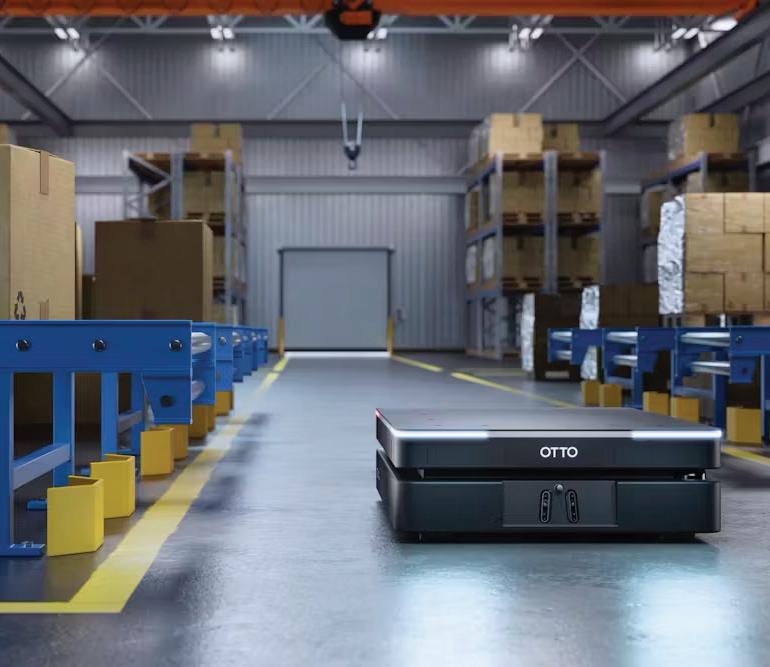
www.therobotreport.com 54 THE ROBOT REPORT April 2024
PickGPT harnesses the power of generative AI for robotics

Generative AI is a groundbreaking technology that was almost impossible to ignore in 2023. While researchers have been finding novel ways to harness generative AI and large language models (LLMs) for robotics, there haven’t been many companies that have been able to commercialize a system combining generative AI and robotics.
This is where Sereact stands out. Last year, it released PickGPT, a robotics transformer that combines LLMs with the company’s computer vision technology. The technology allows robot operators to instruct robots using natural language. By leveraging generative AI, PickGPT enables robots to process natural language and visual information and correlate multimodal data.
PickGPT is a software-based robotics system that doesn’t require programming or training, claimed Sereact. Every day, more robots are deployed in more places, but the number of roboticists and programmers isn’t growing at the same rate. This means robots need to be intuitive enough that those without specialized skills can work with them.
PickGPT reduces the time needed to set up and customize robots, allowing employees to focus on other essential tasks. PickGPT also offers more flexibility and quality control. With

Organization Name: Sereact
Country: Germany
Website: sereact.ai
Year Founded: 2021
Number of Employees: 11-50
Innovation Category: Technology
the robotics transformer, robots can respond quickly and easily to new tasks or changing environmental conditions, which are common in warehouse settings.
PickGPT can also recognize and identify objects and products in real time based on their visual characteristics. These characteristics
can include product titles, descriptions, and other textual information, as well as visual cues. The transformer automatically analyzes product images and matches them with items in any real-world scenario. PickGPT leverages groundbreaking technology to make robots smarter and easier to use. RR

55 THE ROBOT REPORT April 2024 www.therobotreport.com
Simbe scales inventory robotics deal with BJ’s Wholesale Club

Having products in the right place at the right price is critical for retailers. Inventory management, however, remains a painfully manual process. Research shows manual audits are the reason why 60% of out-of-stock items are somewhere else in a store – and 50% of products ordered online are substituted or not found. The lack of accurate inventory data costs retailers $2 trillion per year –$1.2 trillion due to out-of-stocks and $562 billion due to overstock.
Simbe Robotics is helping close these gaps with its Tally inventory management robot. The system leverages computer vision, AI, and mobile robotics to deliver real-time visibility into inventory and pricing. In 2023, Simbe introduced an intelligence platform for wholesalers, updating its cutting-edge technology to accommodate the unique scale and layout of large-format settings.
The team recognized that warehouse clubs, in particular, face complex inventory challenges due to their sheer size. In March 2023, Simbe partnered with BJ’s Wholesale Club to roll out an enhanced version of its Store Intelligence solution, featuring new capabilities for Tally.
Specifically, Simbe’s computer vision now reaches much farther and higher than before, allowing Tally to scan bulk products, pricing, and promotion information on even the tallest club shelves. Simbe’s data capabilities inform product location, replenishment, and pallet optimization, tracking an item’s time-in-steel to provide suggestions for restocking based on upcoming expiration dates.
BJ’s is integrating Simbe’s technology into all 237 of its clubs in the U.S. This huge deployment validates the immediate value and proven performance of the company’s new system. RR
Organization Name: Simbe
Country: U.S.
Website: simberobotics.com
Year Founded: 2014
Number of Employees: 11-50
Innovation Category: Application


www.therobotreport.com 56 THE ROBOT REPORT April 2024
Slip Robotics minimizes trailer loading times with simple approach
Organization Name: Slip Robotics
Country: U.S.
Website: sliprobotics.com
Year Founded: 2019
Number of Employees: 11-50
Innovation Category: Application

Imagine you’re a truck driver finally arriving at your destination after hours of driving. Once you drop off your cargo, you know you have hours more to go before the end of your workday. In between all this driving, you spend a significant amount of time simply waiting for your trailer to be unloaded and loaded again. While there are robots that can unload pallets or boxes individually, Slip Robotics takes a different approach to the problem.
Instead of creating a robotic arm to pick items individually, the company
developed SlipBots called automated loading robots (ALR). It’s a large, omnidirectional mobile robot that can carry up to eight full pallets and a total of 6 tons. Once the pallets are on the ALR, it autonomously drives into a trailer for transport to the next destination.
When it gets there, it drives off the truck and into the warehouse. Once the truck has been unloaded, the ALRs waiting in the wings can drive onto the trailer. This reduces driver wait time from 1.5 hours down to just five minutes, Slip Robotics said. The company said it
can load 20 pallets per minute without driving a forklift into a trailer.
Besides reducing wait times for divers, Slip’s robots can load eight times as many trailers with the same number of operators. It can also reduce material handling damage by 40% by reducing touches and impacts. Finally, the company also improves worker safety. 25% of industrial accidents involve a loading dock, and ALRs make it so operators never need to enter trailers to unload, load, or secure. RR

57 THE ROBOT REPORT April 2024 www.therobotreport.com
Symbotic riding wave of logistics automation demand
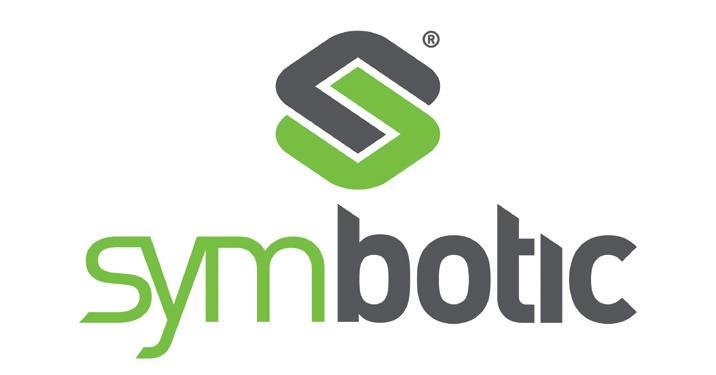
Organization Name: Symbotic
Country: U.S.
Website: symbotic.com
Year Founded: 2007
Number of Employees: 500+
Innovation Category: Application

Most warehouses are inefficient and inflexible, with limited or no automation. Many automation solutions are fixed capital assets that can’t easily adapt to dynamic business conditions.
The modular Symbotic warehouse automation system enables fully automated warehouses with robot-to-robot handoffs throughout. Robotic depalletizers remove cases from inbound pallets one layer at a time. SymBot mobile robots, equipped with advanced computer vision, autonomously navigate a 10-level football-field sized structure at speeds of 20+ miles per hour, storing and retrieving cases and delivering them to outbound cells where robot palletizers with proprietary end-of-arm tools build pallets optimized for downstream nodes.
In 2023, Symbotic made several significant enhancements to the system, including adding cameras and advanced traction control to the SymBots, improved software that orchestrates and powers the system in both the palletization and routing algorithms, and the ability to learn from the up to 6 terabytes of data the system collects per day.
Symbotic is currently selling its system to retailers, wholesalers, and grocers with large distribution operations. It said one client has over 5000+ stores that require daily replenishment. With the Symbotic system, the customer has reduced stock outs, increased the efficiency of store replenishment, and reduced operating costs by 5x.
Symbotic said it has over $24 billion in committed orders from some of the largest retailers, wholesalers and grocers, including Walmart, Target, C&S Wholesalers, Albertsons, and others. Walmart is implementing the system in all 42 of their regional distribution centers.
Symbotic is empowering its customers to operate with unprecedented speed, efficiency, flexibility and accuracy. It helps customers transform their warehouses into a strategic asset with data-driven operations. RR


www.therobotreport.com 58 THE ROBOT REPORT April 2024
TRI builds large behavior models for fast robot teaching
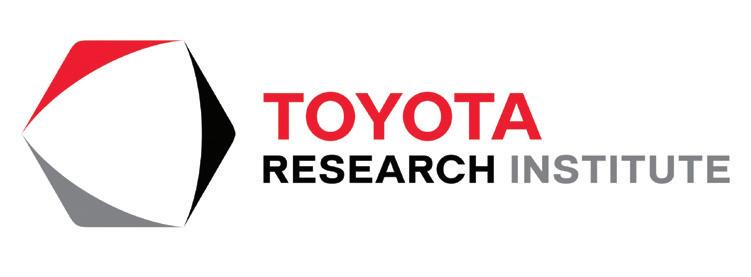
Generative AI garnered a lot of attention last year, but developers have only just started applying it to robotics. In September 2023, Toyota Research Institute, or TRI, announced a potential “breakthrough” approach based on Diffusion Policy to quickly teach robots new skills.
The artificial intelligence advancement was a step toward building large behavior models (LBMs), which could do for robots what large language models (LLMs) have done for conversational AI.
“Our research in robotics is aimed at amplifying people rather than replacing them,” said Gill Pratt, CEO of TRI and chief scientist at parent

Organization Name: Toyota Research Institute
Country: U.S.
Website: www.tri.global
Year Founded: 2015
Number of Employees: 101-500
Innovation Category: Research
company Toyota Motor Corp. “This new teaching technique is both very efficient and produces very high-performing behaviors, enabling robots to much more effectively amplify people in many ways.”
Previous AI approaches had limitations such as narrowly defined tasks and the need for numerous timeconsuming iterative cycles, according to TRI, which has offices in Los Altos, Calif., and Cambridge, Mass.
In TRI’s approach, a teacher instructs a custom two-armed robot with haptic demonstrations, and the system then uses Diffusion Policy to learn the skill. It can do so with dozens of demonstrations in days rather than the weeks spent coding and testing.
The Drake model-based design provided TRI with a toolbox and realistic simulation platform. The optimization framework began as an internal model and has since been released as opensource.
TRI said it has taught robots to do more than 60 tasks such as pouring liquids, using tools, and manipulating soft objects by supplying them with new images and tactile sensing data rather than by writing code. TRI said it hopes to reach 1,000 skills by the end of 2024.
By enabling robots to interact with the world in more varied ways, TRI is making them better able to support people in everyday, unstructured environments. RR
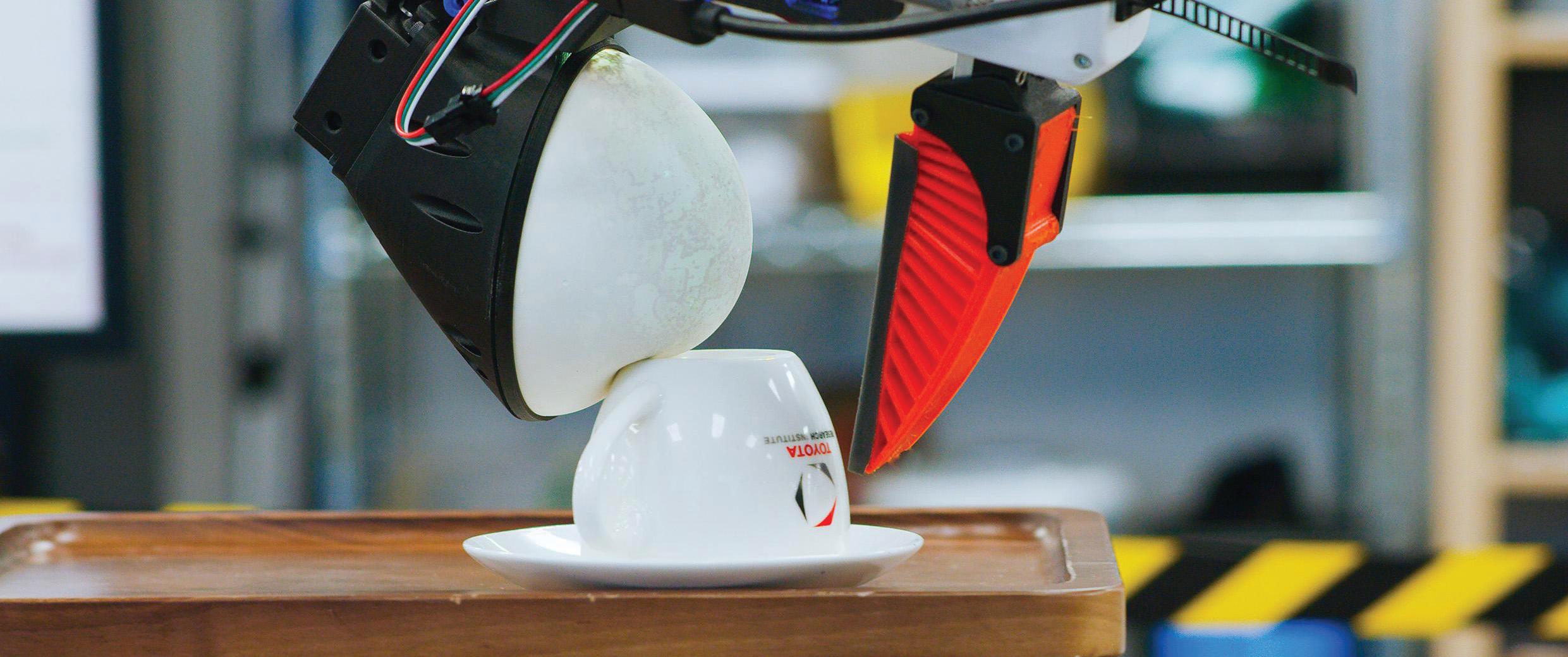
59 THE ROBOT REPORT April 2024 www.therobotreport.com
ULC Cable Splicing Machine to improve safety, power grid reliability

Homes, businesses, and more depend on a reliable and resilient electric grid. The connections between cables can be improperly spliced, leading to system stress and power outages. Highly trained operatives typically have to make hazardous manual repairs.
ULC, the Hauppauge, N.Y.based unit of SPX Technologies, and Con Edison Company of New York developed a system that automates the termination of medium-voltage cables. Version 3 of ULC’s Cable Splicing Machine brought the technology out of the proof-of-concept stage into a prototype to be tested in real-world conditions.
The Cable Splicing Machine can perform complex operations in underground vaults. It consists of several independent subsystems controlled by a centralized computer and a user interface.
The system can be secured to the middle of an uncut cable and uses electrical actuators for precise motion control along the axial and circumferential directions. This enables continuous 360-degree operation.
The Cable Splicing Machine includes numerous tools capable of stripping back each layer of the cable to a desired dimension using precision tool-depth controls. ULC said it has updated tooling to improve robustness and adaptability so different types of cables can be addressed even faster than before.

Organization Name: ULC Technologies
Country: U.S.
Website: ulctechnologies.com
Year Founded: 2001
Number of Employees: 51-100
Innovation Category: Application
Several auxiliary subsystems can carry out additional steps such as shorting and cutting the cable. This, in combination with live camera feeds, allows an operator to monitor and verify the process from beginning to end from outside the manhole with no direct human intervention.
ULC’s technology can improve utility worker safety and shorten feeder
outage duration. This reduction in complexity puts less stress on the power grid, which is particularly helpful when adverse weather puts stress on other components. The company offers its systems through a robots-as-a-service (RaaS) model. RR
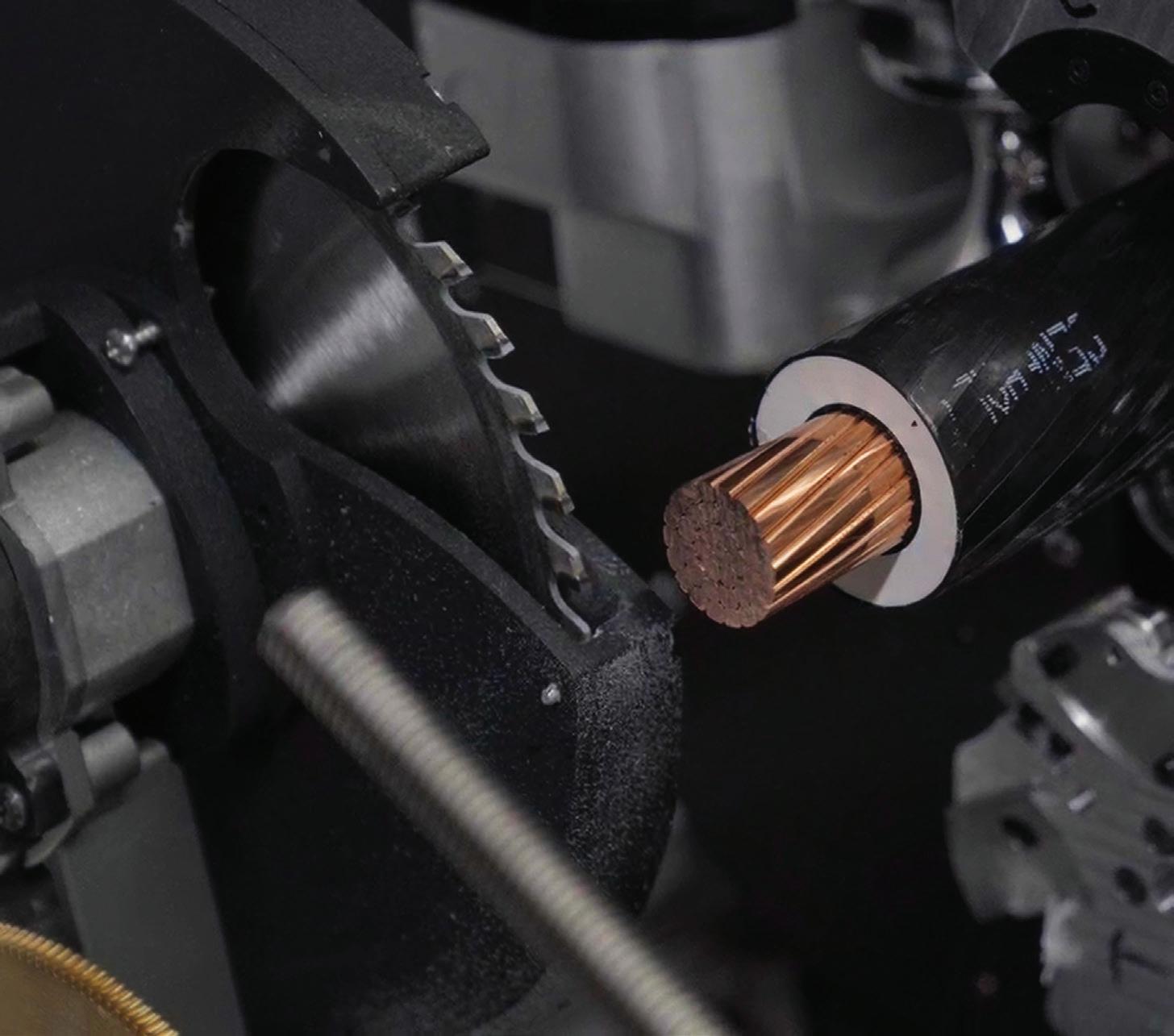
www.therobotreport.com 60 THE ROBOT REPORT April 2024
Universal Robots strengthens cobot lineup with UR30

Universal Robots has been the world’s leading developer of collaborative robot arms for a number of years. In 2023, the Teradyne subsidiary generated $375 million in revenue. Teradyne has said its robotics portfolio, which also includes Energid (motion planning software) and Mobile Industrial Robots (autonomous mobile robots) has penetrated less than 5% of its market opportunity.
Universal Robots (UR) continued to diversify its cobot lineup in 2023 with the introduction of the UR30. With a 30 kg (66.13 lb.) lifting capacity, 1,300 mm (51.2 in.) reach, and weight of 63.5 kg (139.9 lb.), the UR30 can tend larger machines, palletize heavy products, and support high-torque screw driving.
Built on the same architecture as the UR20, the UR30 cobot arm offers more payload capacity in a compact footprint. Anders Billesø Beck, vice president of strategy and innovation at Universal Robots, told The Robot Report that the UR30 was in development for more than a year before it was introduced. He said that, despite the popularity of the UR20, some customers wanted a robot with a smaller footprint and a higher payload capacity.
The UR30 offers six degrees of freedom and a new “steady mode” that it said opens up the cobot arm to different screwdriving applications, including in the automotive industry.
The diversification of its product line should enable UR to maintain its position atop the cobot arm market. While the UR30 isn’t the first cobot to offer a 30 kg payload, it comes with UR’s top-notch global support, industry-leading accessories, training, and service programs. This continues to make UR a true one-stop shop for a user’s collaborative robotics needs. RR
Organization Name: Universal Robots
Country: Denmark
Website: universal-robots.com
Year Founded: 2005
Number of Employees: 500+
Innovation Category: Technology

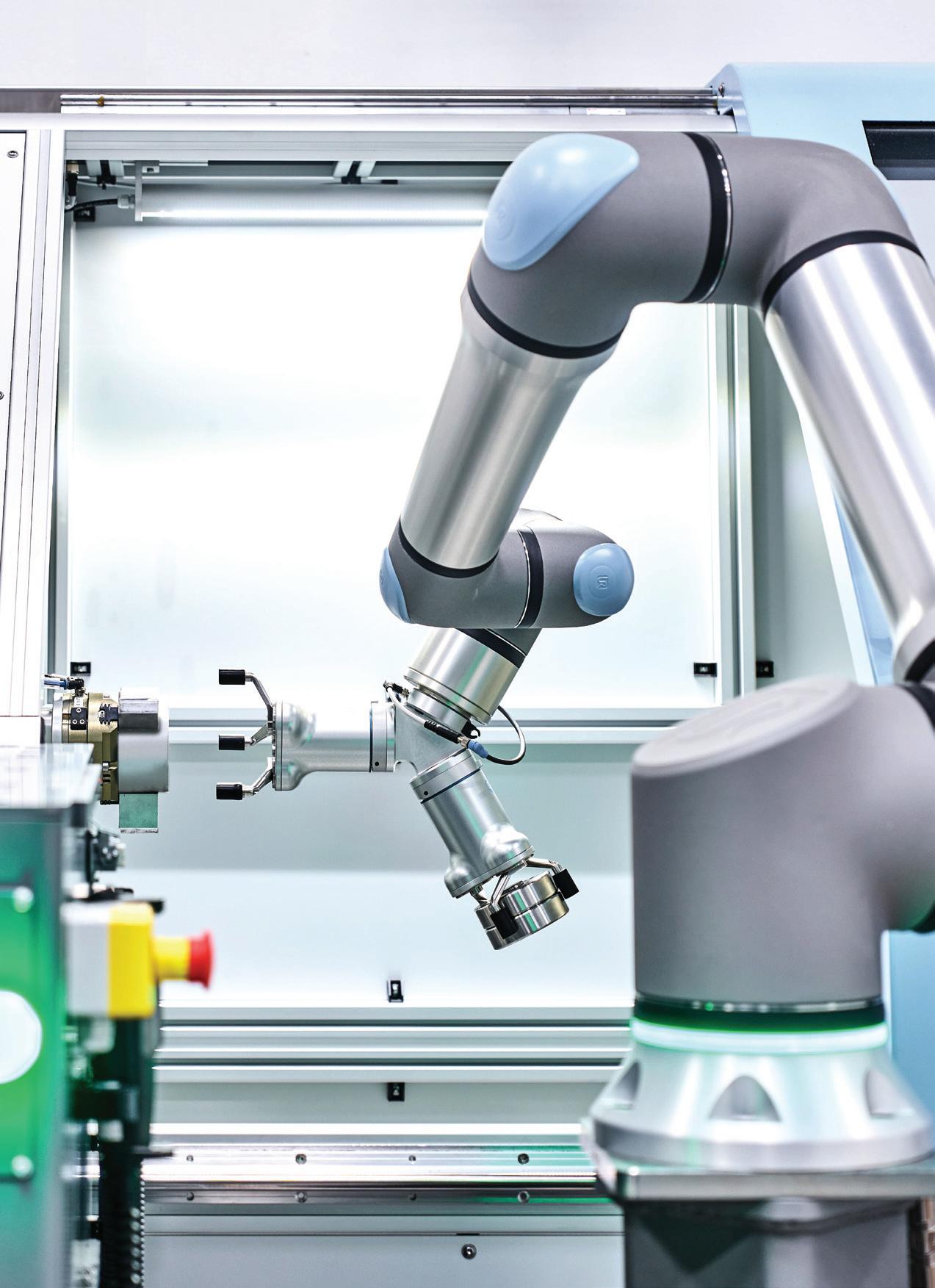
61 THE ROBOT REPORT April 2024 www.therobotreport.com
GAM provides a full range of zerobacklash robotic flange gearboxes
GAM’s extensive product offering includes three different zero-backlash gearboxes: Strain Wave (harmonic), Cycloidal, and the revolutionary Zero-Backlash Planetary.
• GPL zero-backlash planetary gearbox features a unique design ensuring backlash of ≤ 0.1 arcmin for the life of the gearbox. The GPL provides vibration-free motion and high positional accuracy for precise smooth path control and repeatability with a life of 20,000 hours.
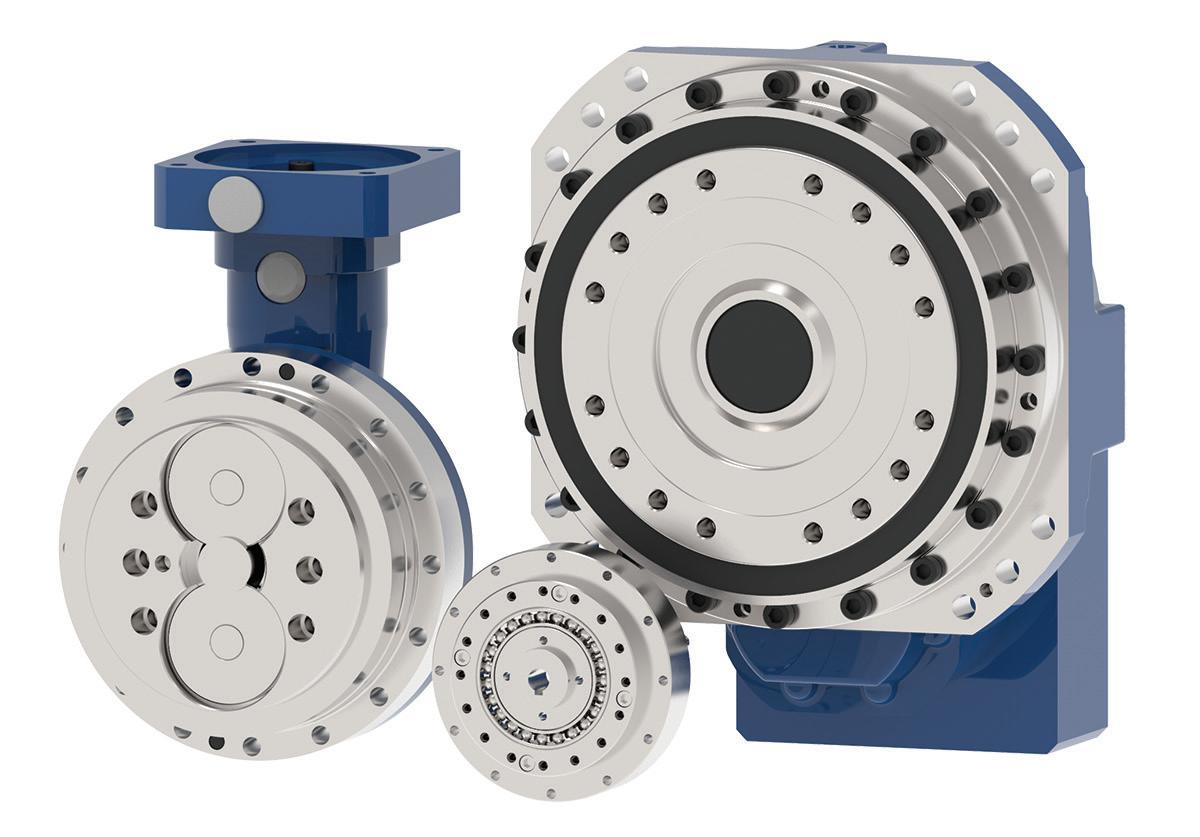
• GCL cycloidal gearbox provides precise pointto-point motion and high impact resistance of 5x nominal torque with the option of an integral prestage.
• GSL strain wave gearbox uses harmonic-type gearing for high accuracy and drops in for popular competitor gearboxes.
• With three options, GAM can provide the zerobacklash robotic flange gearbox for your precision application.
Extra Large, Hollow Shaft Speed Reducer
The new FBS Series gear unit features an extra large hollow shaft with a compact outer diameter that is ideal for robots and machines requiring complex cabling to pass through the axis of rotation. It includes large cross-roller bearings, enabling the load to be mounted directly to the output and is available in two sizes (25, 32) and three reduction ratios (30:1, 50:1, 100:1).

www.therobotreport.com 62 THE ROBOT REPORT April 2024 ROBOTICS 42 Dunham Ridge Beverly, MA 01915 United States www.Harmonicdrive.net
ROBOTICS GAM Enterprises, Inc. 801 E Business Center Drive Mount Prospect, IL 60056 888.GAM.7117 | 847.649.2500 www.gamweb.com info@gamweb.com
With Ensenso C, IDS Imaging Development Systems has launched a stereo vision camera that not only generates 3D point clouds, but also delivers 2D color images thanks to an additional image sensor. The IP65/67 camera is delivered preconfigured and is therefore easy to integrate. It reliably detects objects even in difficult lighting conditions. High resolution, industrial quality, ready to use.

High Performance Joint Drive
The market demands specific robots for industrial and service applications. Together, our customers and the maxon specialists define and develop the required joint drives. A customized drive system with high power density and competitive safety functions make our drives the perfect solution for applications in robotics. Our drives are perfectly suited for wherever extreme precision and the highest quality standards are needed and where compromises cannot be tolerated.
Features at a Glance
• Continuous (RMS) torque: 34Nm
• Repeatable peak torque: 57Nm
• Hollow shaft: 20mm
• Zero-backlash gear
• Dual-encoder with absolute output encoder
• EtherCAT position controller
• 2.5kg
Ensenso C: 3D point clouds and color images ROBOTICS

IDS Imaging Development Systems Inc.
92 Montvale Ave, Suite 4750
02180 Stoneham, MA
United States
+1 (781) 787-0048 | www.ids-imaging.com


• Design Configuration: motor, gear, brake, encoder and controller maxon 125 Dever Drive Taunton, MA 02780
63 THE ROBOT REPORT April 2024 www.therobotreport.com
ROBOTICS
www.maxongroup.us | 508-677-0520
Check out POSITAL’s new generation of encoders!
POSITAL has launched a major upgrade to its IXARC family of incremental and absolute rotary encoders, featuring new magnetic sensor technology and more energy-efficient microcontrollers. Mechanically and electrically compatible with earlier models, the new encoders combine improved performance with reduced power consumption.


An encoder series designed for use in harsh environments
POSITAL Inc.
1 N. Johnston Ave. Suite C238
Hamilton, NJ 08609 USA
609-750-8705 | info@fraba.com

Renishaw’s FORTiS™ delivers superior repeatability, reduced hysteresis, and improved measurement performance due to an innovative non-contact mechanical design that does not require a mechanical guidance carriage. It provides high resistance to the ingress of liquids and solid debris contaminants. It features an extruded enclosure with longitudinally attached interlocking lip seals and sealed end caps. The readhead body is joined to a sealed optical unit by a blade, which travels through the lip seals along the length of the encoder. Linear axis movement causes the readhead and optics to traverse the encoder’s absolute scale (which is fixed to the inside of the enclosure), without mechanical contact.
Renishaw, Inc.
1001 Wesemann Dr. West Dundee, IL, 60118
Phone: 847-286-9953
Email: usa@renishaw.com
Website: www.renishaw.com
www.therobotreport.com 64 THE ROBOT REPORT April 2024
ROBOTICS
ROBOTICS
THK Micro Cross-Roller Ring Series RAU
The THK micro-size Cross-Roller Ring RAU features a 10mm inner diameter and a 21mm outer diameter. It is more compact, lightweight and rigid than a double row angular contact ball bearing type. RAU rollers travel on V-shaped raceways ground into the inner and outer rings. Alternating rollers are arrayed orthogonally so that one bearing can support loads and moments in any direction. Spacer retainers enable smooth movement and high rotation accuracy.

https://www.thkstore.com/products/rotation/cross-roller-rings/rau.html

Robotics Weeks
LIVE AND ONDEMAND WEBINARS COVERING THE WORLD OF ROBOTICS
AUTOMATED WAREHOUSE
From mobile robots and automated storage to picking, palletizing, and sortation systems, warehouse operators have a wide range of options to choose from. To get started or scale up with automation, end users need to evaluate their own processes and environments, find the best fit for their applications, and deploy and manage multiple systems.
THK America, Inc.
200 East Commerce Drive Schaumburg, IL 60173
847-310-1111 | www.THK.com

Automated Warehouse Week will provide guidance, with expert insights into the evolving technologies, use cases, and business best practices.


ROBOTICS ENGINEERING
Robotics Engineering Week features keynotes and panels, delivered by the leading minds in robotics and automation, addressing the most critical issues facing the commercial robotics developers of today.
65 THE ROBOT REPORT April 2024 www.therobotreport.com
ROBOTICS
REGISTER TODAY roboweeks.com





























































































































































































